
Moving like snails down the road to Los Angeles, California.
Dreams, Moments, Travels

Moving like snails down the road to Los Angeles, California.
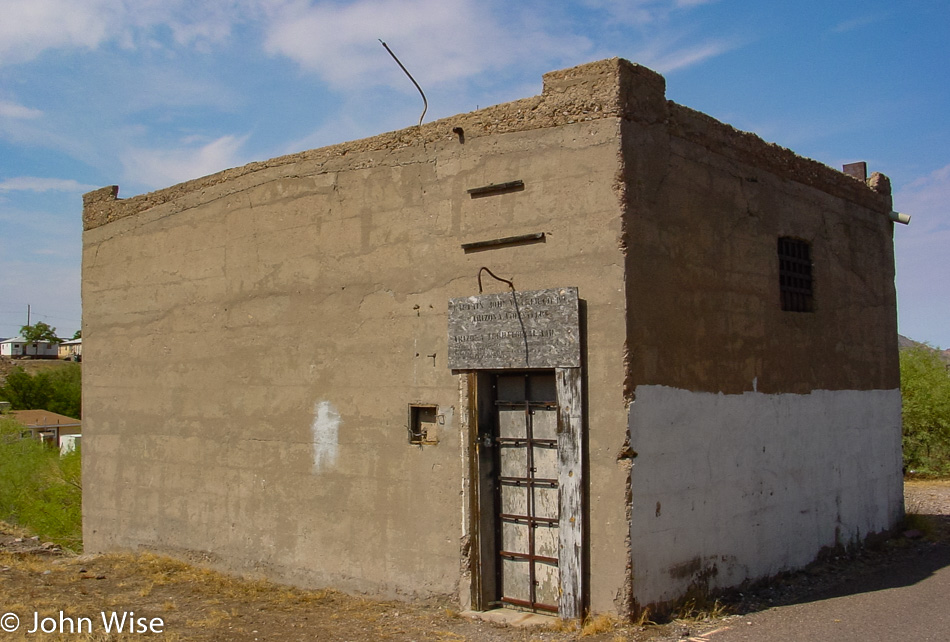
This is the Arizona Territorial Jail in the old town of Superior, and it is either the smallest or at least one of the smallest jails in Arizona. Built around 1916, according to some, although the faded sign on the building says something or other about 1884 and mentions Civil War officer Captain John Walker.
The purpose of this out-and-back single afternoon trip is simply to photograph some decaying buildings and their surfaces so I can either take inspiration from them or allow them to refresh my memories of details of places visited.
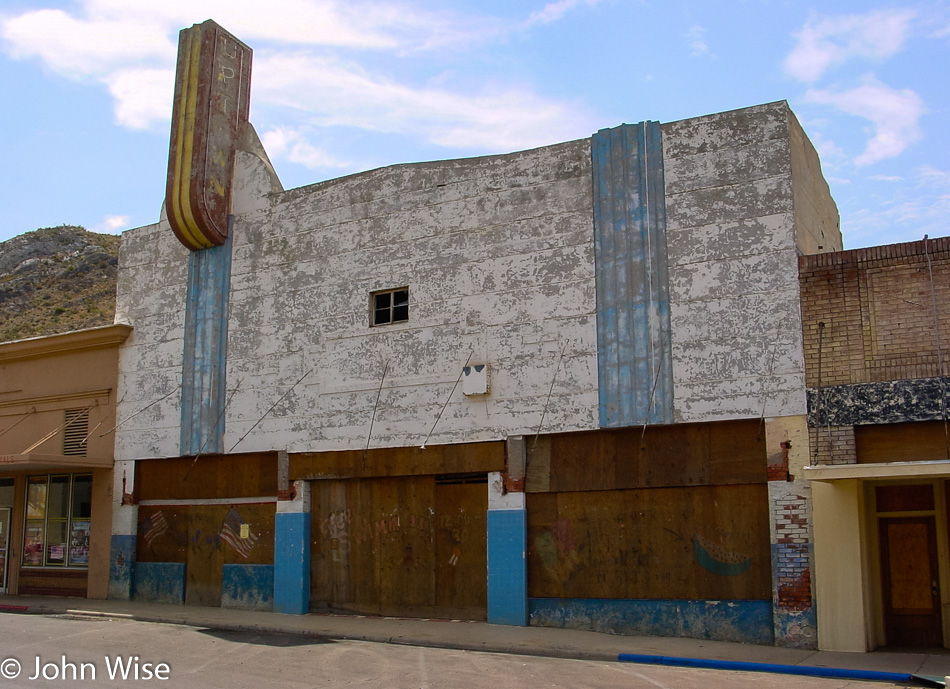
The Uptown Theater here in Superior used to sell movie tickets for a mere $0.28, which included a snack and tax back in 1923 when it opened. If only I had the guts to break in, I’d love to see what the place looks like inside and imagine those who were able to see the magic of the movies out in this dusty mining town some 75 years ago.
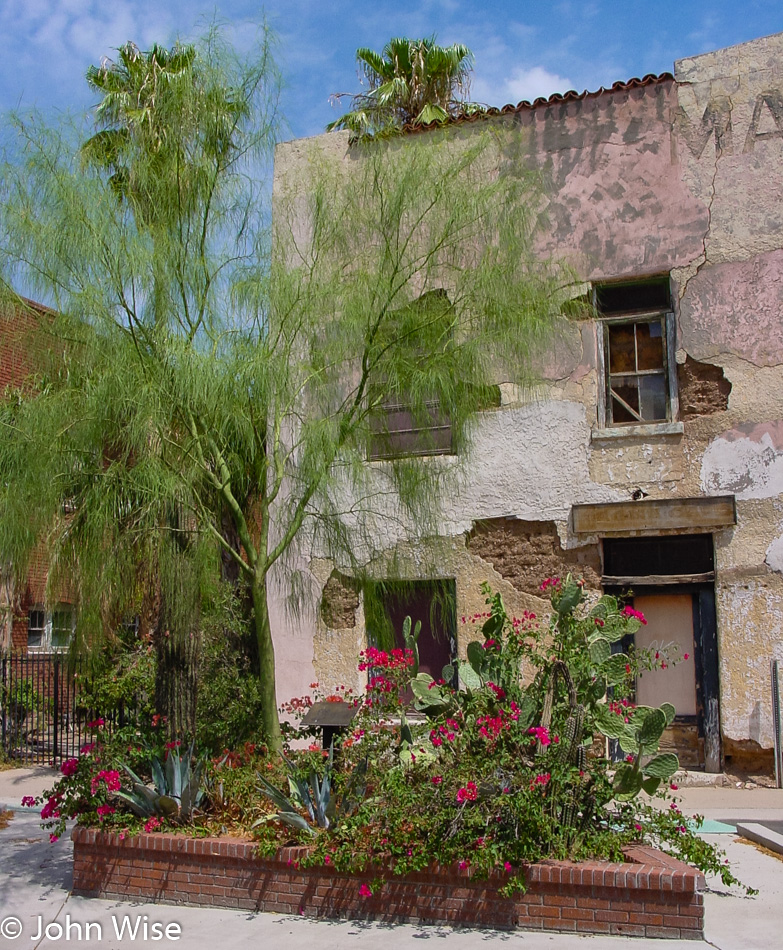
MacPherson’s Magma Hotel is just waiting for someone to come in and give it some tender, loving care.
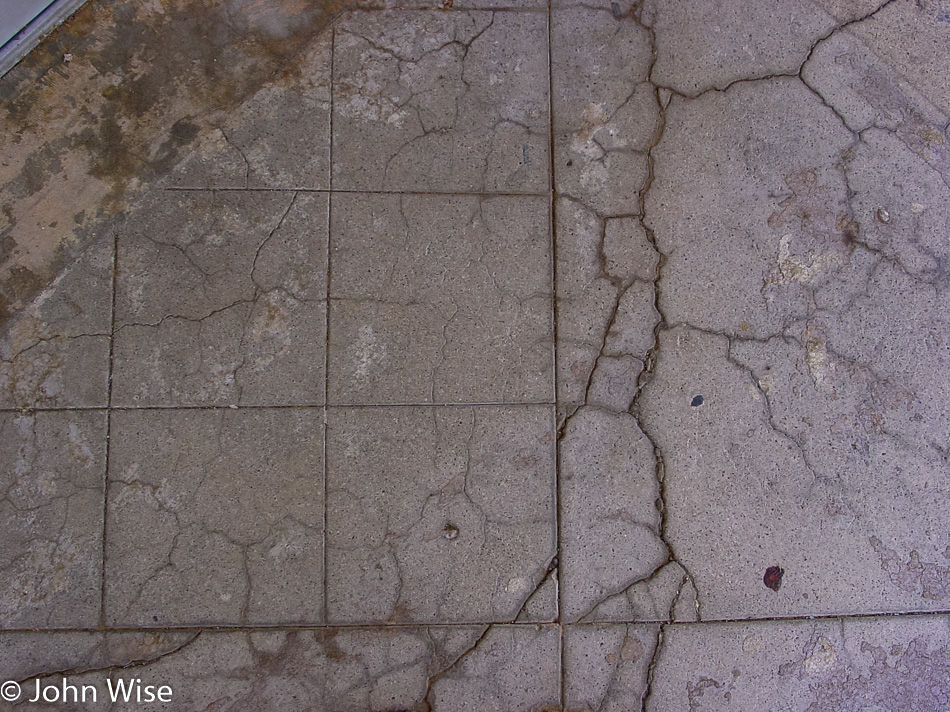
The world is not just in front of your face; it is also below your feet should you decide it’s worth looking at. Just think that Sean Penn or Joaquin Phoenix might have stepped right here during the filming of U-Turn.
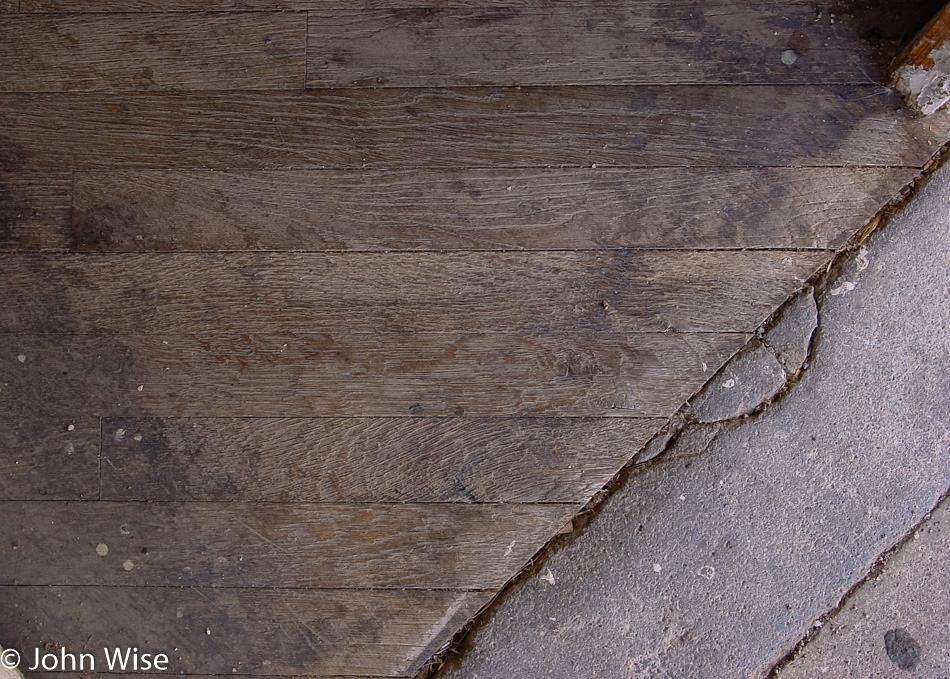
These old buildings and places that are being abandoned or neglected are a treasure trove of surfaces that have worn beautifully with the passage of time. New is not always the most beautiful.

Signs offer great insight into the history of a place. When was the last time “Agents” made visits to homes and offices?

I tried to learn something about Weis Market here in Superior but have come up empty-handed. Amazing bit of weathering going on.
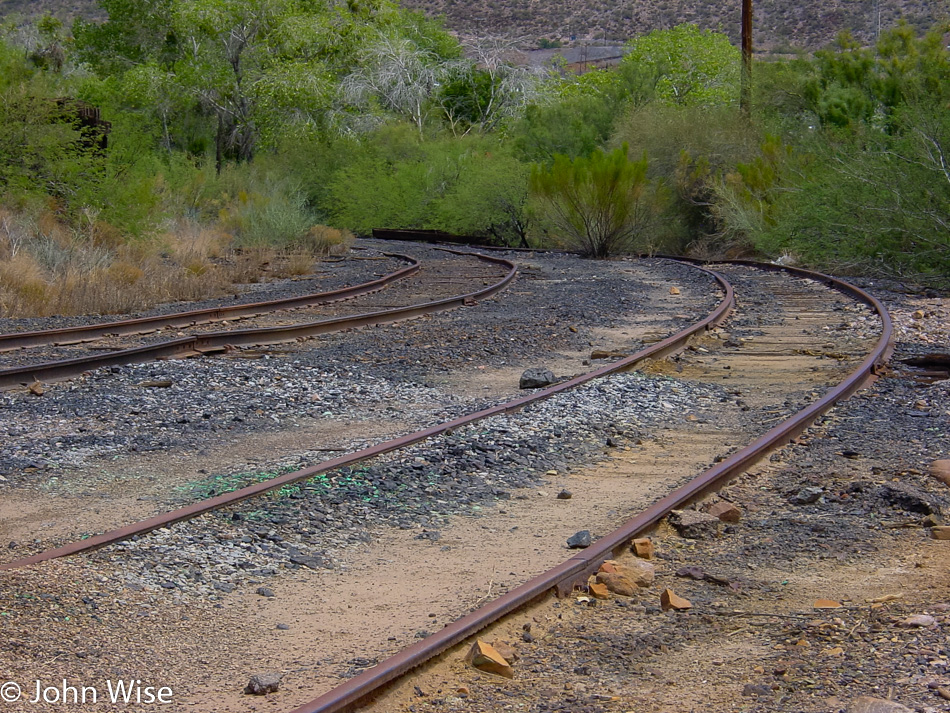
Old steam trains used to ply these tracks hauling ore out of the mines. Initially, silver was being mined here, but when silver dropped from $1.50 an ounce to only 20 cents an ounce, it was time to shut the mine or start hauling out copper, and for the next 86 years, that’s how the town survived.
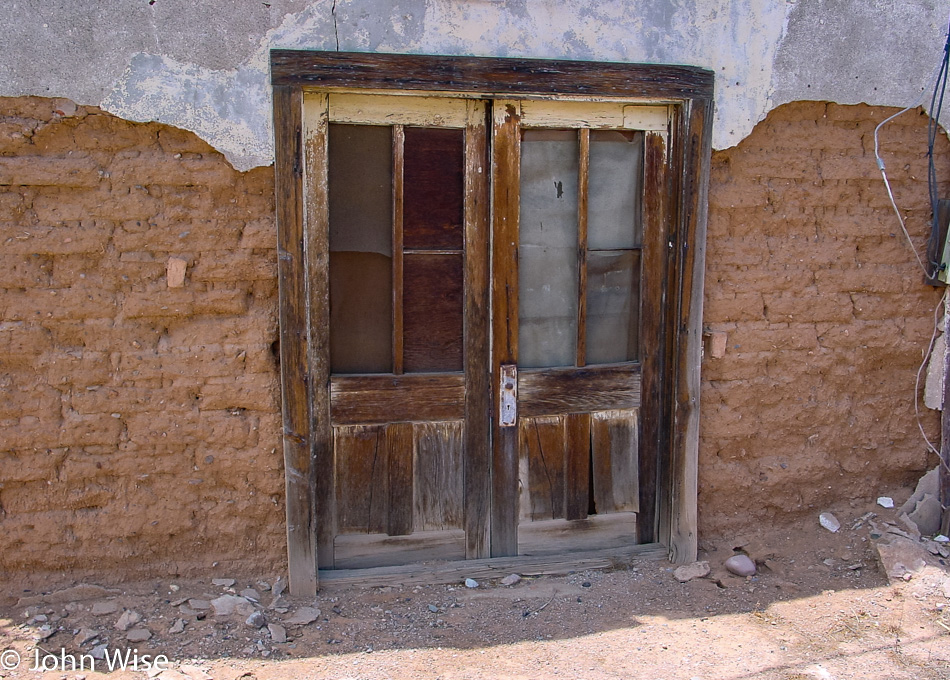
I believe I took this near Kane Springs Canyon down an old dirt road, but as I write this much later, my memory could be faulty.
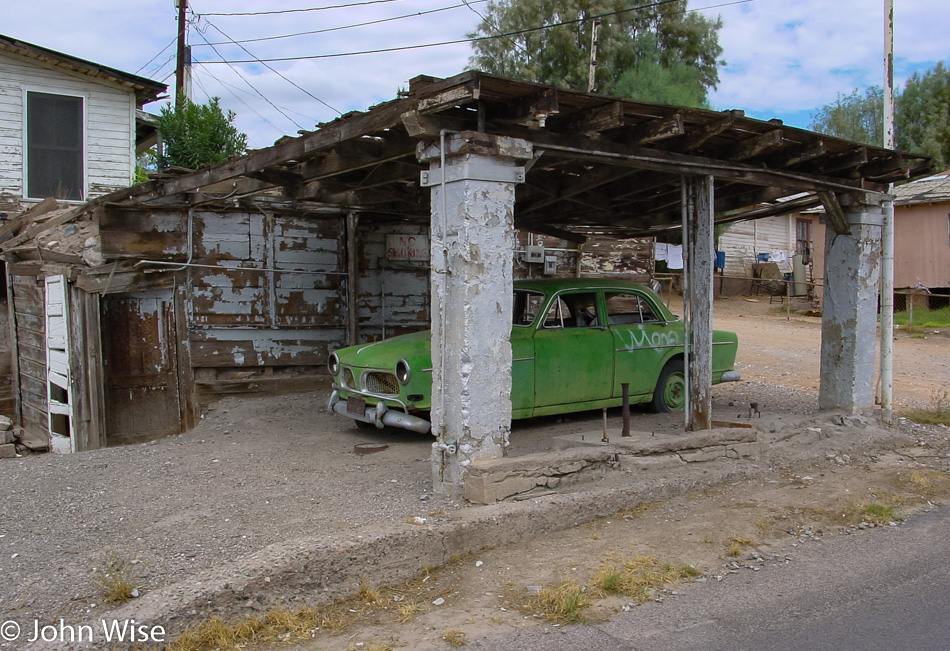
Possibly the oldest gas station ruin I’ve ever seen is here in Hayden, Arizona, another town devastated by the ebb and flow of mining operations.
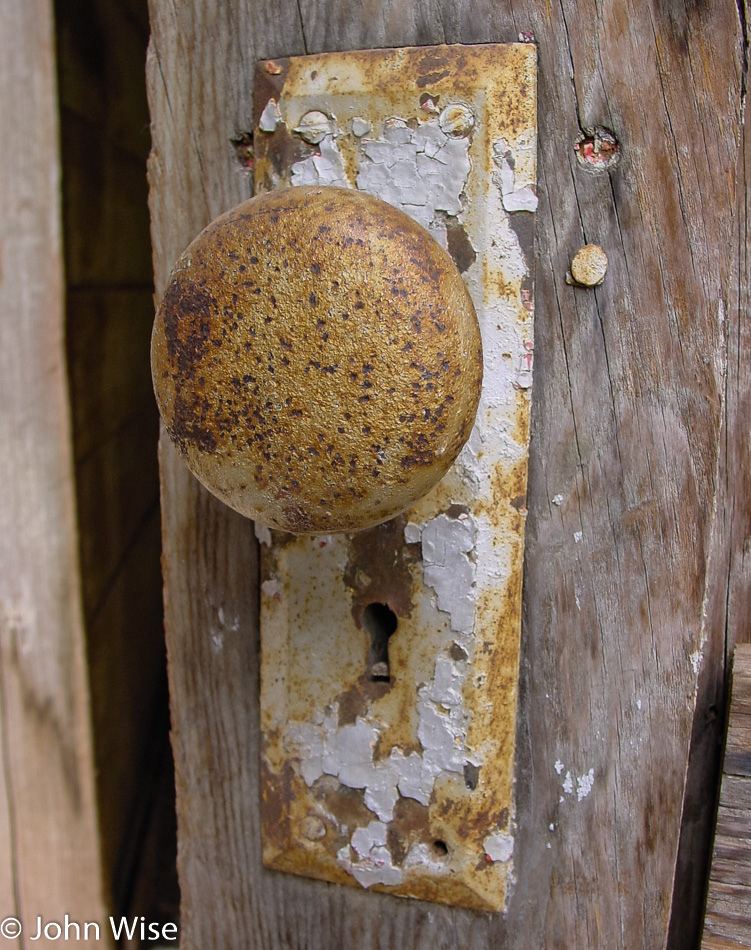
If I didn’t need constant tetanus booster shots due to the rusting handle, I’d have this doorknob at home in an instant.
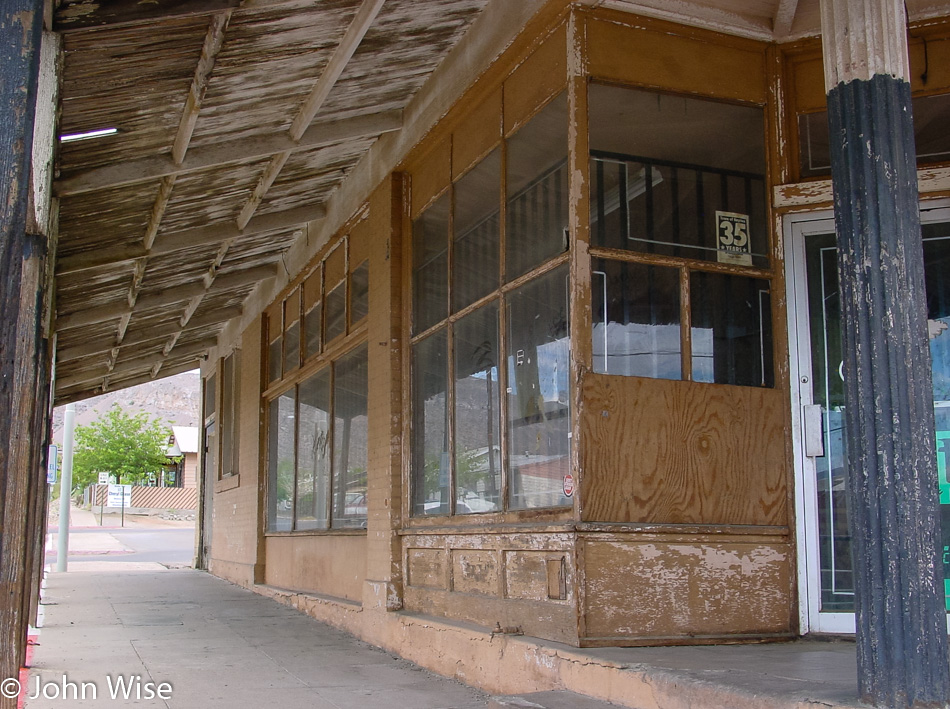
From this old town which is quickly turning into a ghost town, came one famous citizen, Dick Tuck. Born Richard Gregory Tuck in 1924 right here in Hayden, he was better known as Dick and was a political consultant, campaign strategist, and political prankster. On the Watergate tapes, President Richard Nixon can be heard talking about the guy.
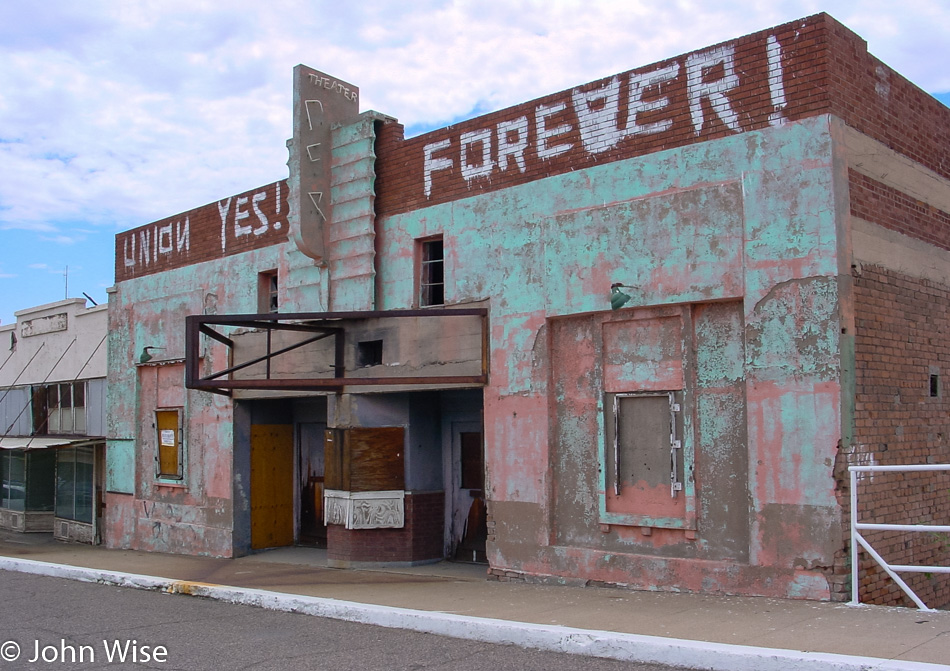
Rex Theater on Hayden Avenue hasn’t shown a movie here since 1979. This old mining community has an interesting tale that reflects many small towns across America’s similar problems with aging populations, declining opportunities, industries that closed shop, and those who apparently cannot afford to leave. To read more about Hayden, click here.
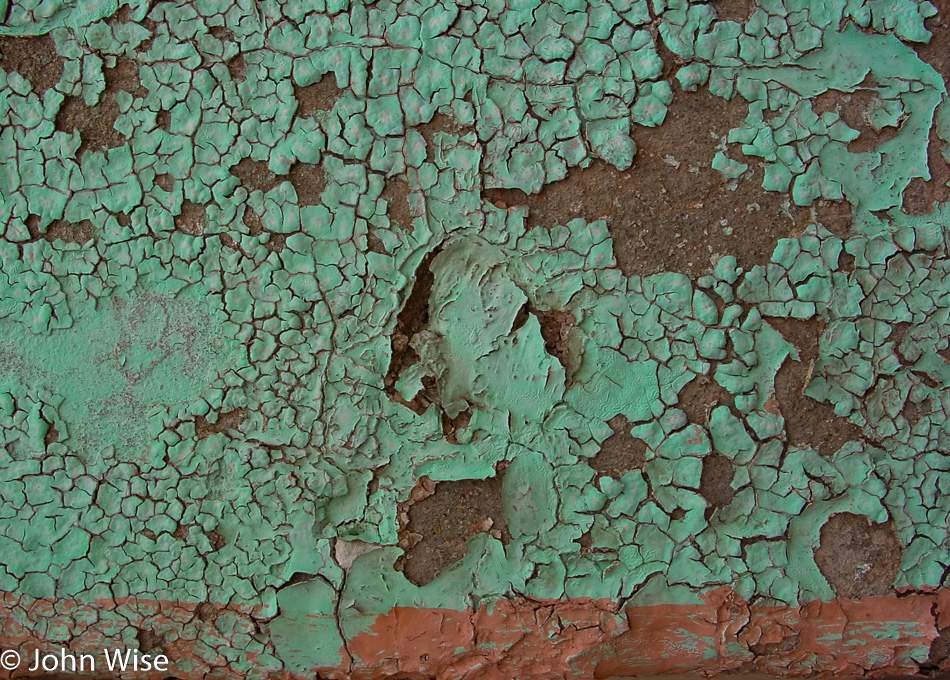
Paint bakes in the sun, chips off in the wind and rain, and ultimately allows the rest of the building to start turning to dust.
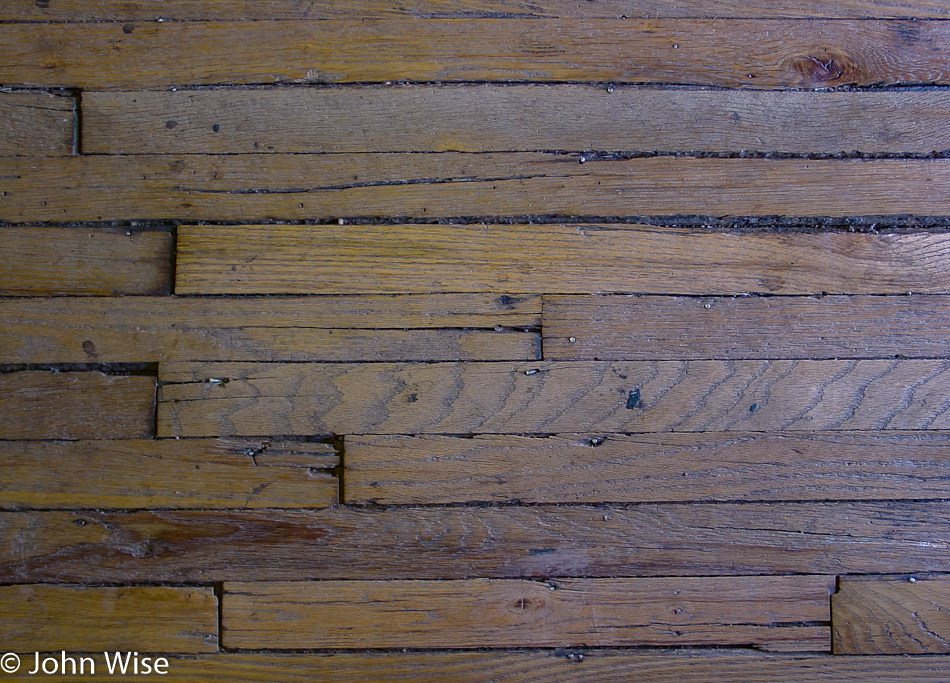
I just love the irregular lines, shapes, and aging that make up these places. While they were perfect in their time, they are worthless to the future.
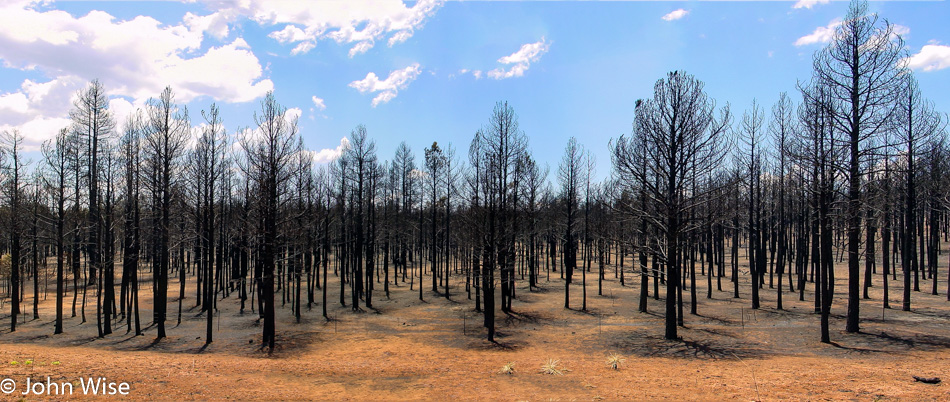
Just a week ago the Rodeo–Chediski fire was brought under control and about to be put out, but it had burned 468,638 acres (732 square miles) and destroyed 426 buildings since it started back on June 18th. This fire was the combination of two events; one started by an arsonist and the other by someone stuck in the wilderness with a broken all-terrain vehicle, trying to get help. Seeing the forest floor scrubbed clean is strange enough, but seeing the shadows of the leafless trees on the ground adds to the peculiar sight.
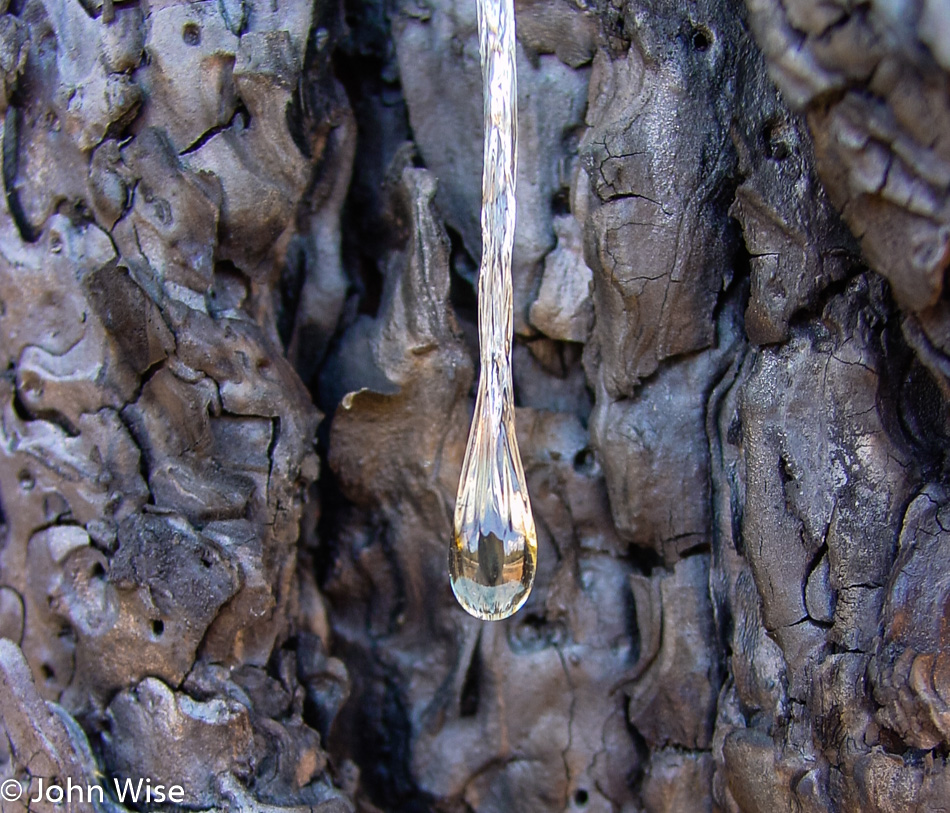
Among the trees, the sap that had been boiled out of them was everywhere. Within all this tragedy, I find something beautiful.
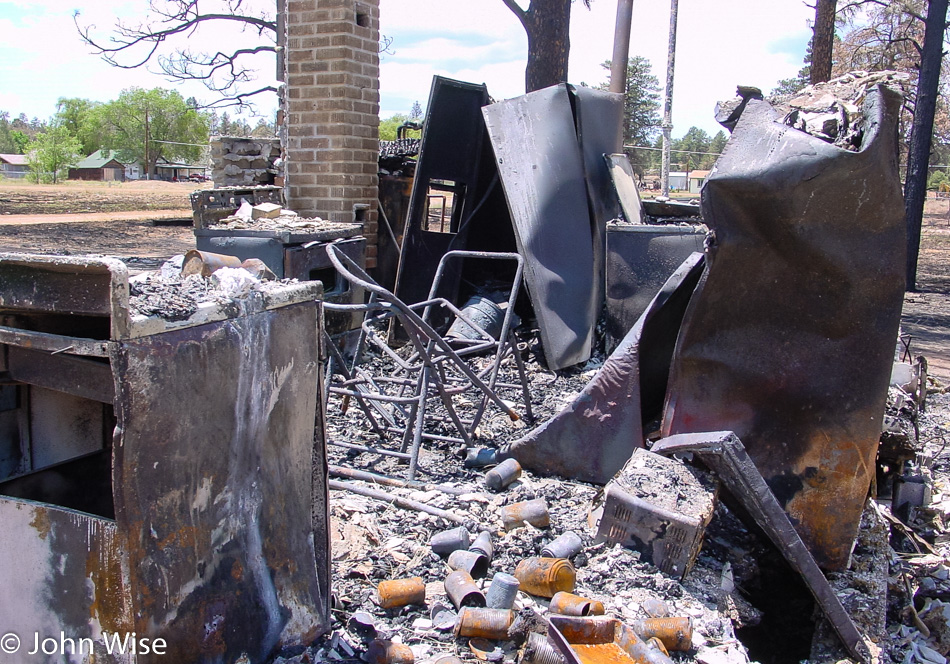
I feel for the people who lost their homes and the pain they must cope with at such an enormous loss.
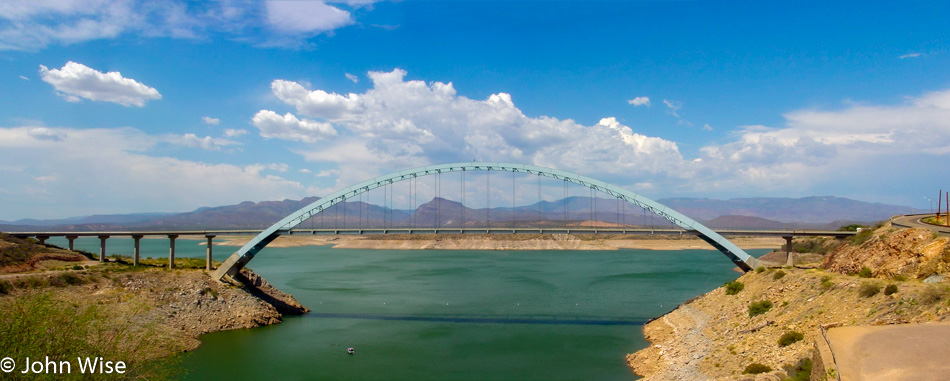
Can’t let the downer of that devastating fire be the extent of what my eyes will witness today, so I turned off the road to detour over to Roosevelt Lake Bridge. Back in 1911, U.S. President Theodore Roosevelt dedicated the dam that bears his name, but it wouldn’t be until 1990 that the bridge was built. The dam was too narrow for modern cars, and so the bridge became a necessity. It is the longest two-lane, single-span, steel-arch bridge in North America. The bridge spans 1,080 feet across Roosevelt Lake, and while one can continue to Highway 60 further south, a shortcut to Phoenix via the Apache Trail is also found right here.
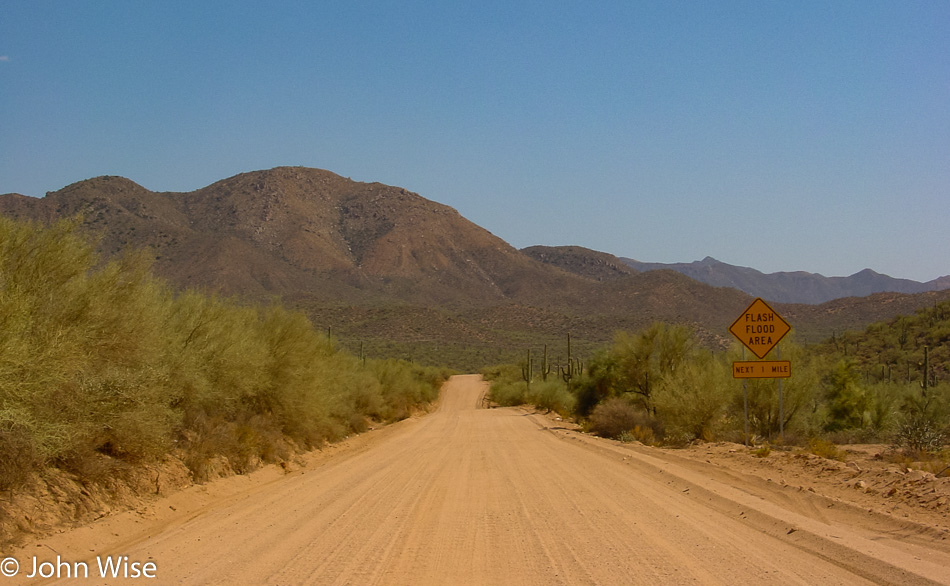
I’m opting for the dusty, unpaved Apache Trail, which is nearly 30 miles of a twisty, winding, sometimes very narrow road that travels through a gorgeous slice of Arizona and leads into the Superstition Mountains over to Tortilla Flats.
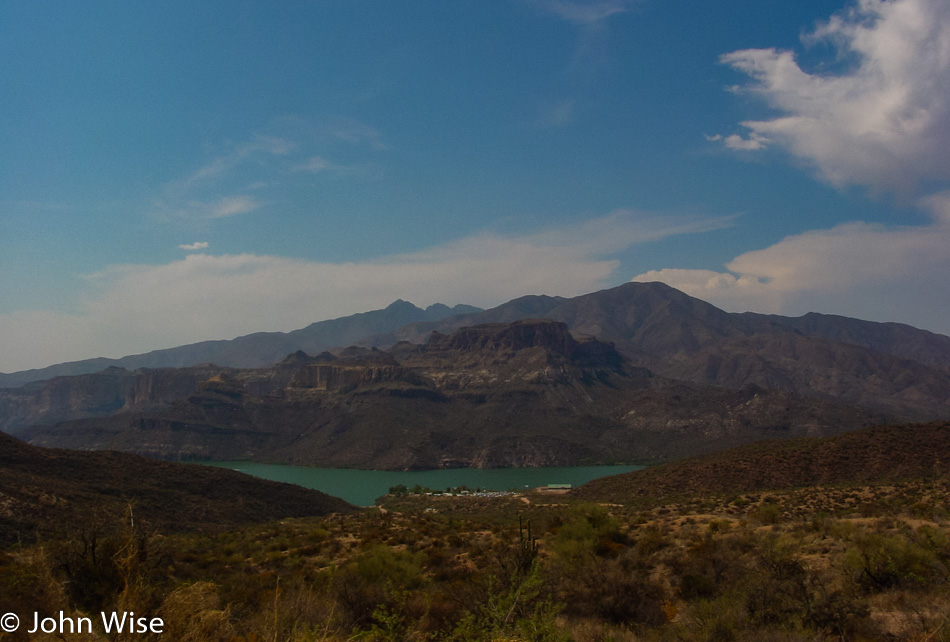
Apache Lake in the distance. It’s not uncommon to see trucks pulling boats on this primitive road to hang out at this popular recreation site.
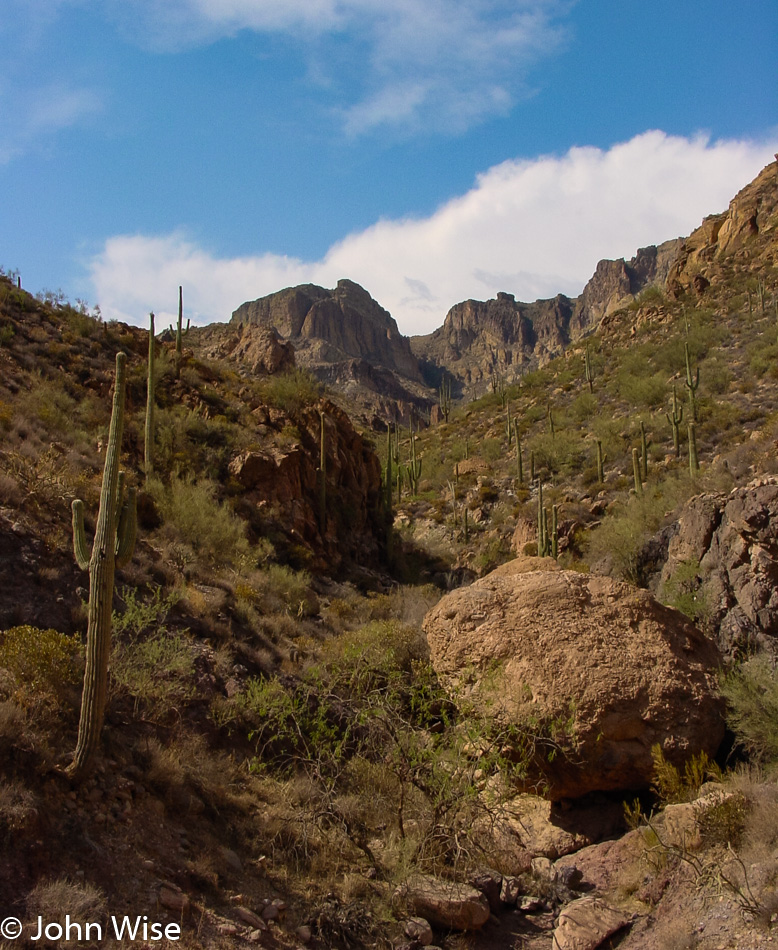
The Superstition Mountains where legend has it there’s a lost gold mine somewhere out in the wilderness.
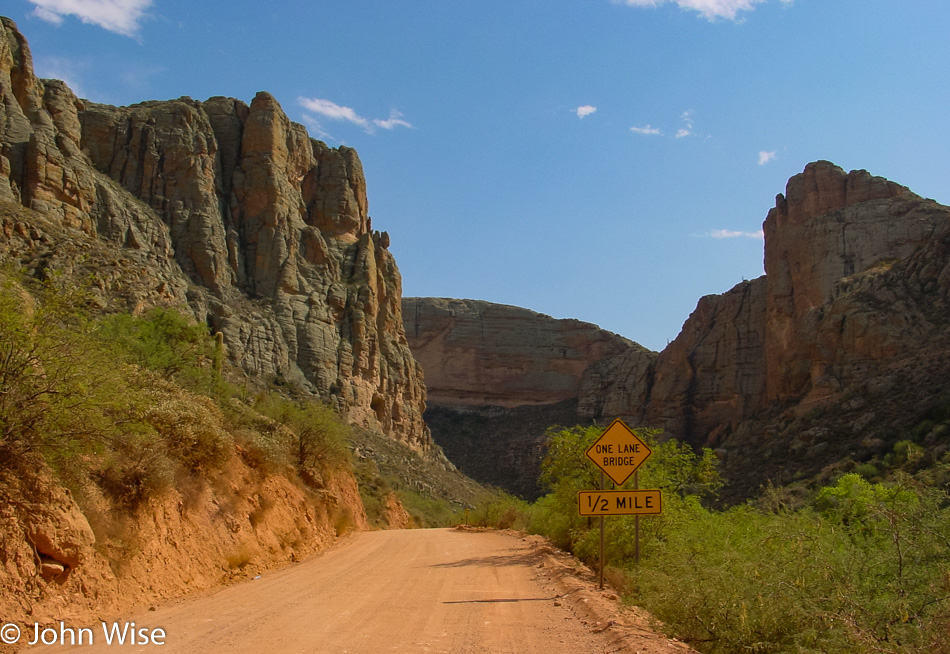
Some parts of the dirt road are in pretty good shape and are easily navigable, while others are nail-biters with blind corners that induce fear that someone towing a boat should come around the corner and force you to back up.
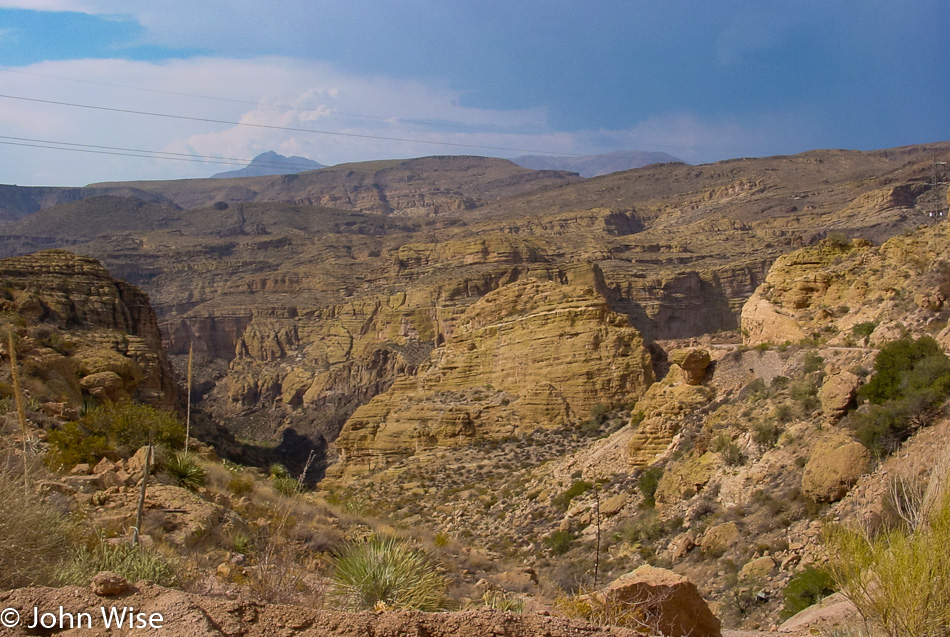
As I said earlier, it’s a beautiful route for those able to deal with less-than-ideal driving conditions.
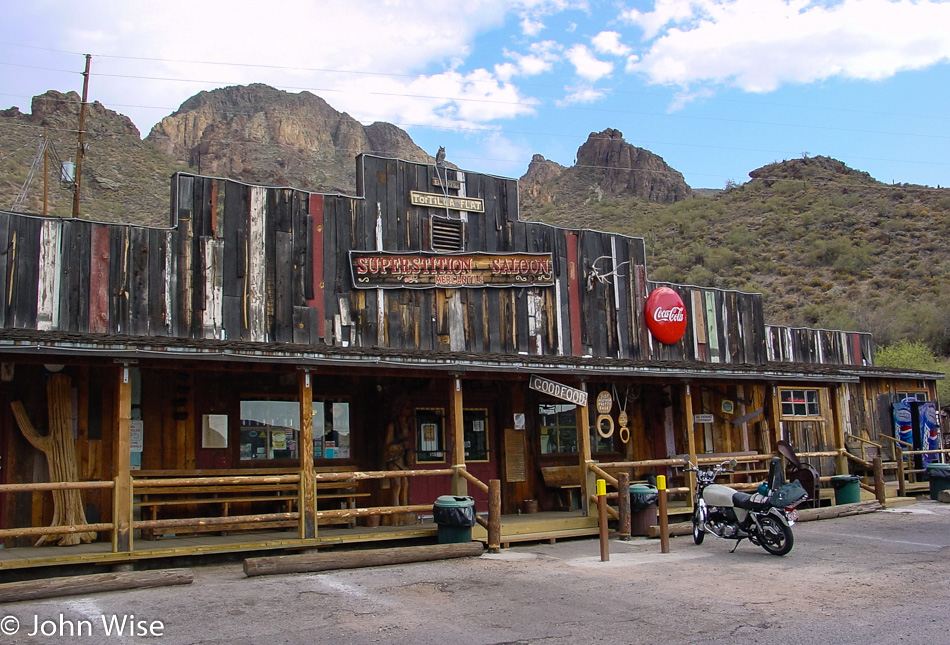
Towards the end of the route, you can reward yourself with a visit to the Superstition Saloon in the famous biker hangout of Tortilla Flat.
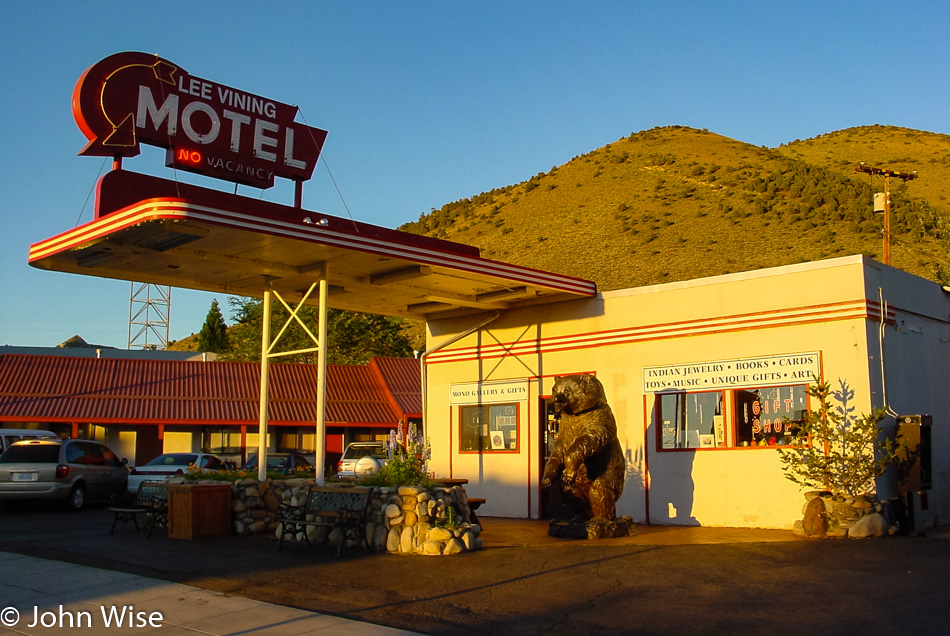
It’s not even 6:00 in the morning yet but already we’ve missed the sun coming up over the horizon. Time to hit the road for a repeat of some of yesterday. Our motel is located right next to Route 120, also known as Tioga Road, making our next move very convenient.
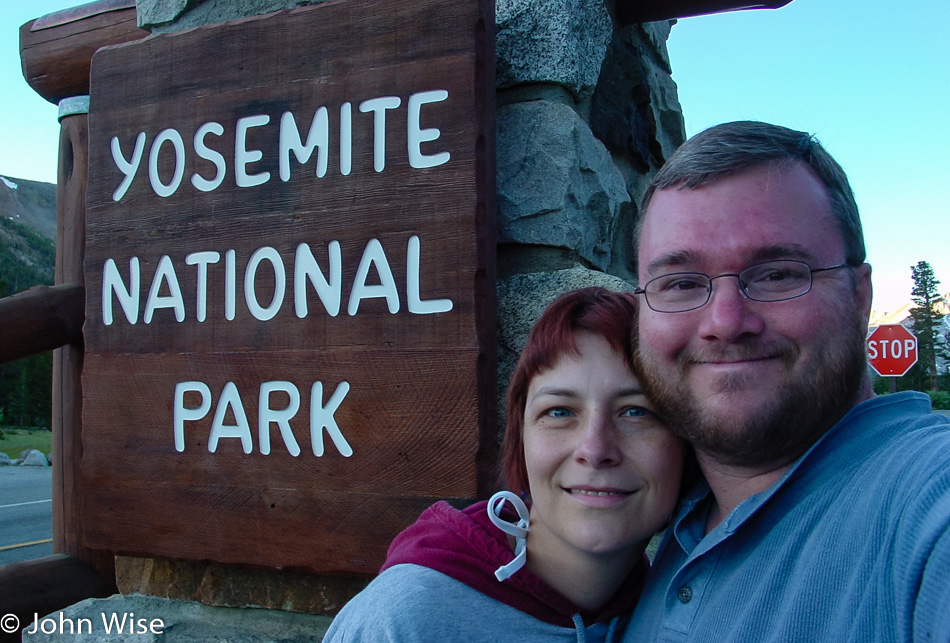
Up here by the park entrance, the sun is yet to rise, but if you look over my shoulder you can see it on the mountain tops. Yesterday was so beautiful we are throwing caution to the wind, and instead of going home and arriving at a reasonable time, we decided to drive back up the Tioga Pass to catch a few more glimpses of a side of Yosemite we’d not seen before.
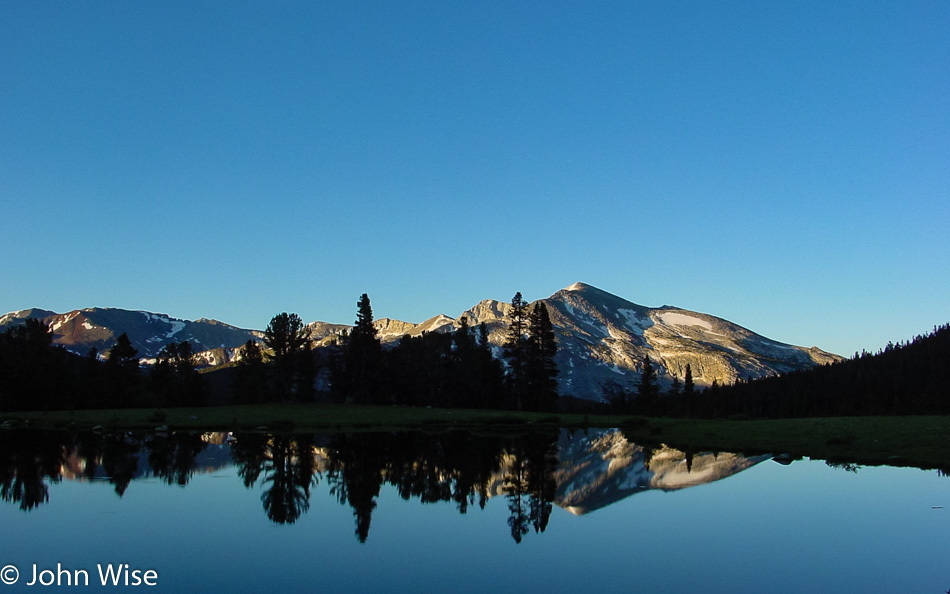
Tenaya Lake looks quite different in the early morning, not better, not worse, just different and still magnificent.
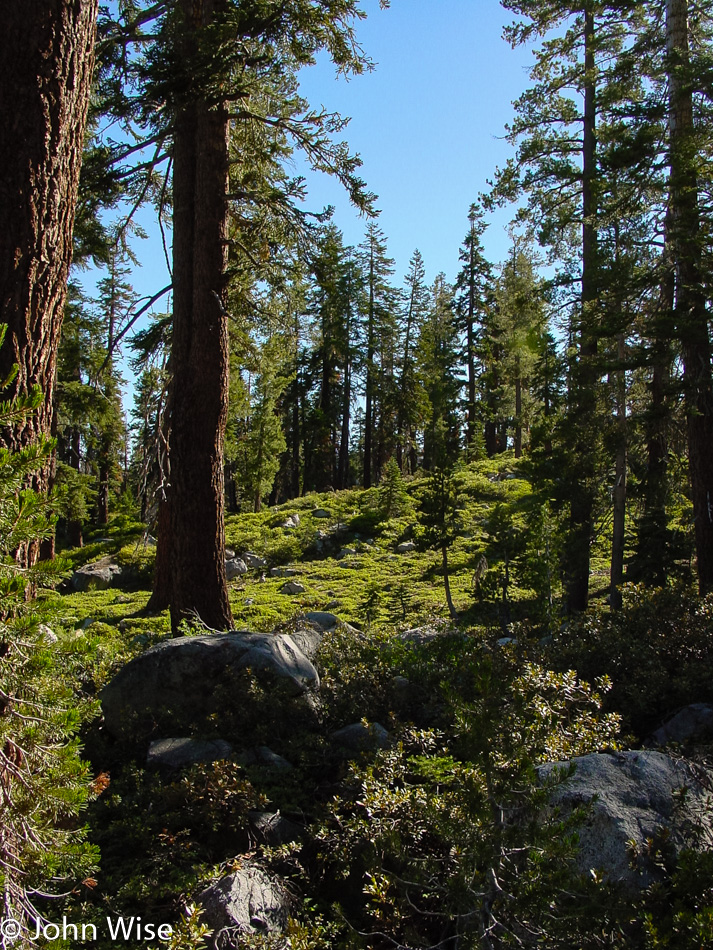
We are venturing further into the park than we were able to yesterday as we were losing daylight.

Siesta Lake was as far as we were willing to go, and we accepted that we couldn’t do it all even though we try. Just seeing upper Yosemite in this light has made our detour worth everything we have to give up in sleep.
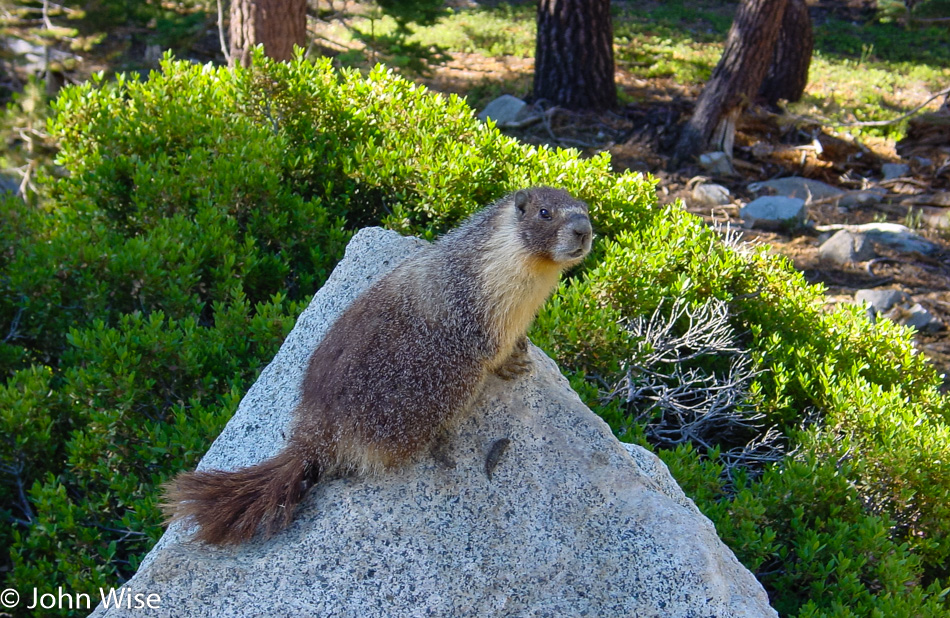
Back at our car, a proud marmot was posing with its scat that, in its world, must be a super load otherwise, why the staredown?
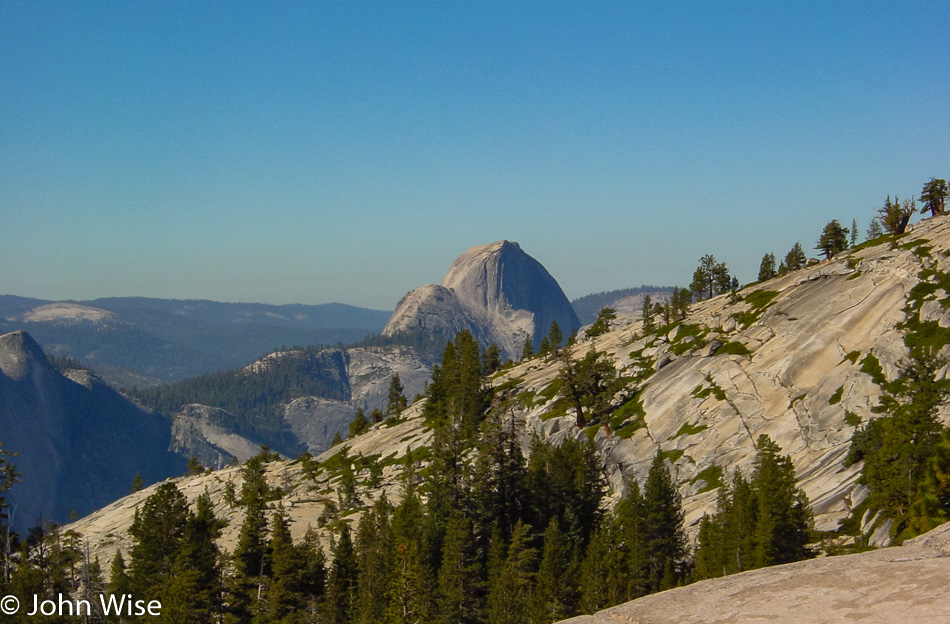
The view from Olmsted Point offers a look at Half Dome that I’m guessing few ever get to see based on how light the traffic up here yesterday and this morning was, it can easily be surmised that the majority of park visitors only go to Yosemite Valley.
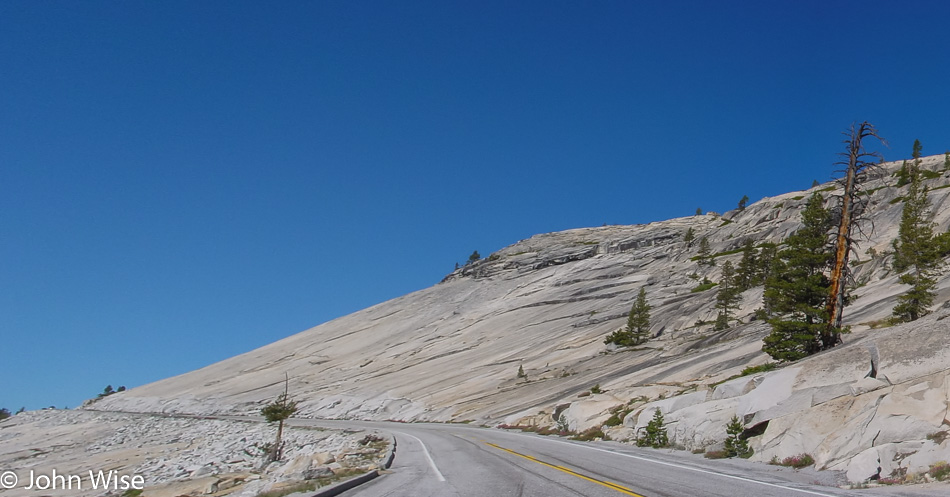
Another view from Olmsted Point.
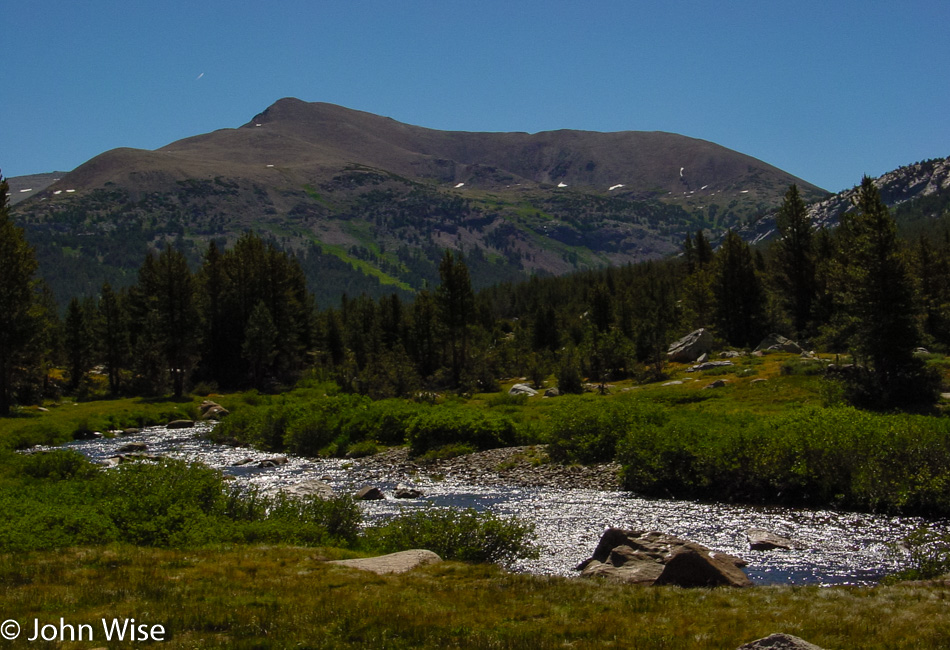
Our last encounter of greenery meeting water before we descend into the desert and its harsh environment.
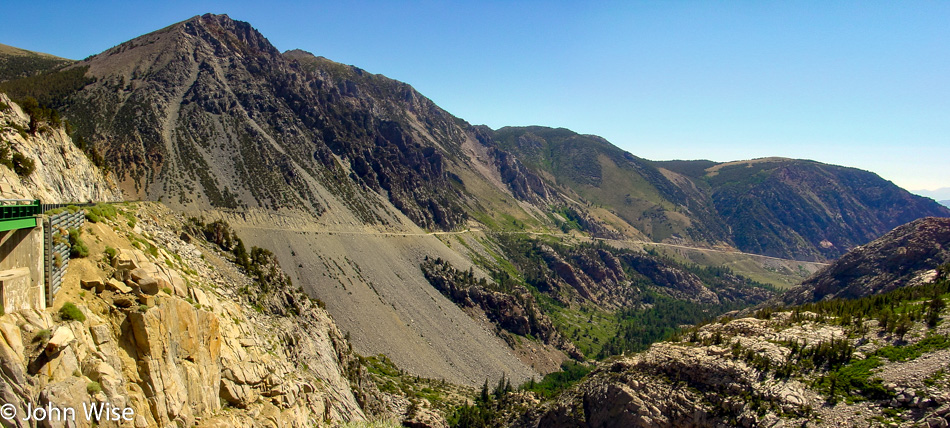
Viewed from here, driving over that scree slope looks sketchy.
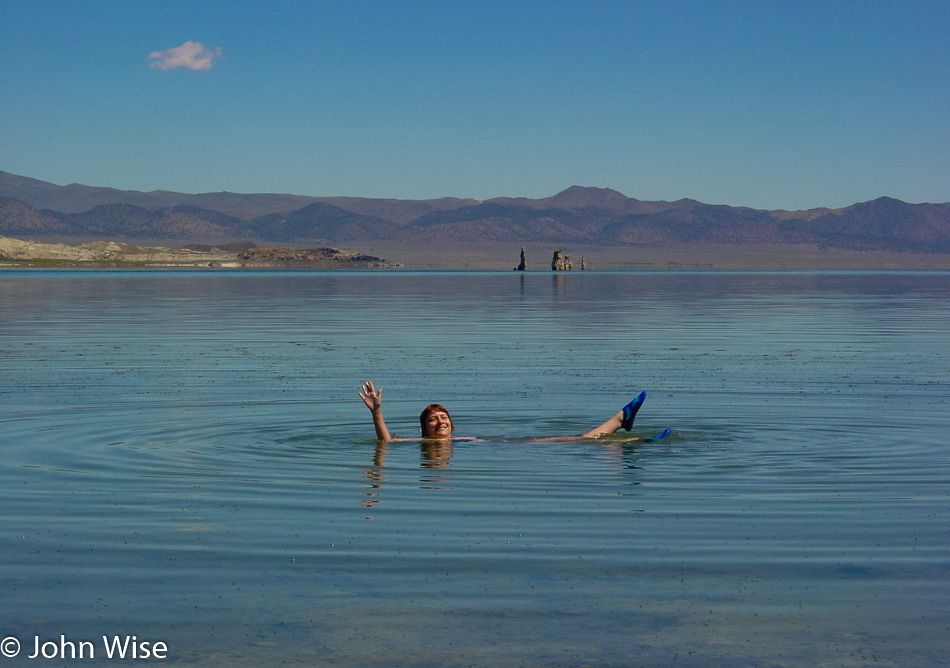
Hey anyone up for a swim in the salty water of Mono Lake with the brine shrimp and blackflies? Of course, Caroline would be interested in making her way through the swarming critters both in the water and on its surface; she’s kind of a badass in that way.
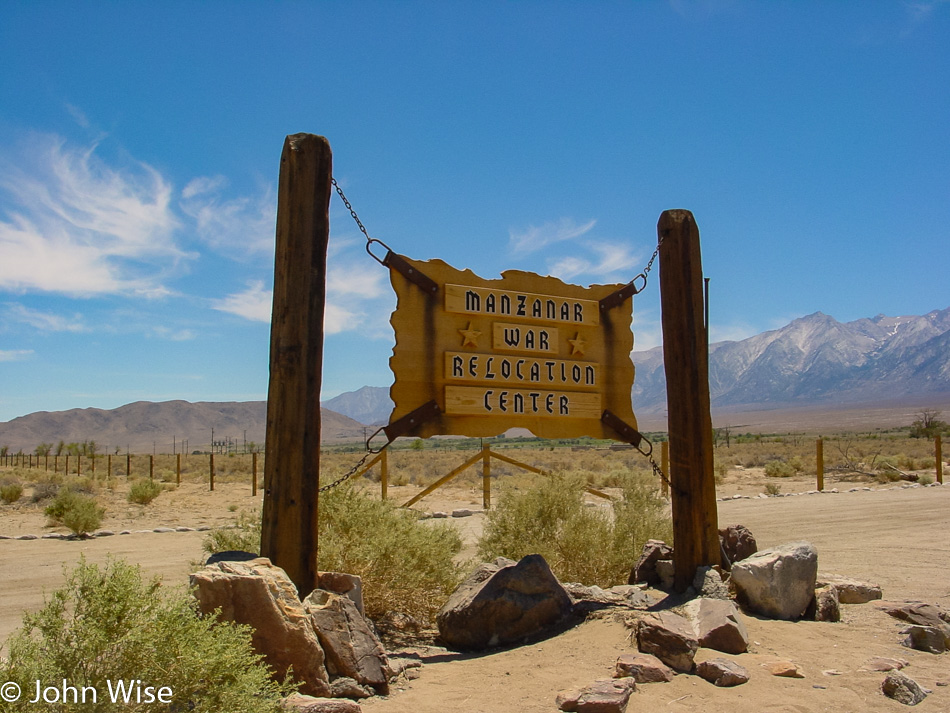
Welcome to one of America’s largest concentration camps from World War II. This is the Manzanar War Relocation Center, where a lot of Japanese American citizens ended up, but this was only one of the ten camps in America. In total, our country rounded up 120,000 Japanese and their families, removing them from their communities, land, property, and businesses and fully uprooting their faith in the American system of justice.
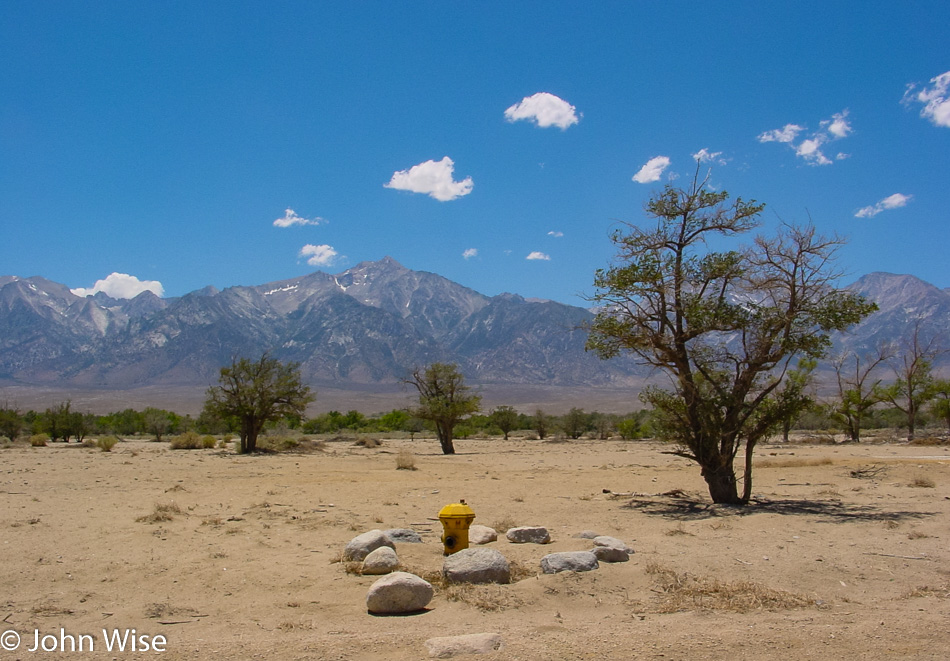
It was December 1942 when Edward R. Murrow told the American people that the German concentration camps were, more precisely, extermination camps, and yet since February of the same year, the United States was operating concentration camps of their own. While it could be argued that the American position of incarcerating these fellow Americans didn’t result in their deaths, the xenophobia that gives rise to these types of actions are the flames of hatred that, once unleashed, can be difficult to extinguish.
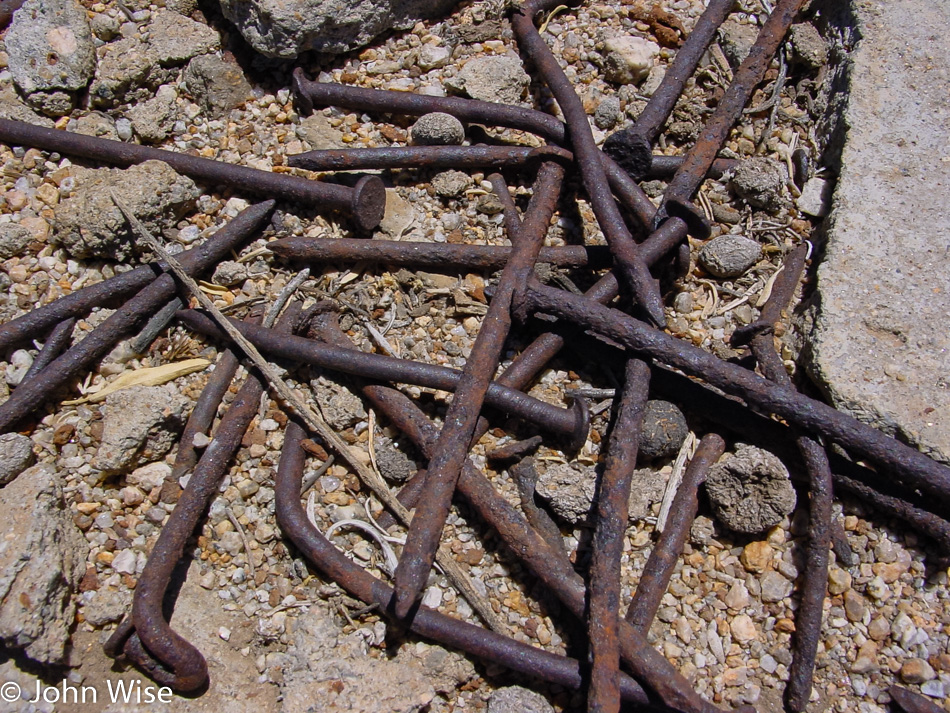
The rusty nails hammered into our freedoms, into the hearts of a loyal citizenry, into our constitution are then pulled out and left in the sun as grim reminders that our sense of right and wrong can be unpredictable and shifted like so much sand in the wind. When we institutionalize hate as we have for Native Americans, African Americans, Jewish Americans, Muslim Americans, Gay Americans, Mexican Americans, Irish Americans, and any of the other ethnic and religious groups that we as a society have sanctioned hatred for, we are not being the best we can be. We descend into petty small-mindedness and debase what we claim to stand for. We are not inclusive; we are elitists who have lost their way.
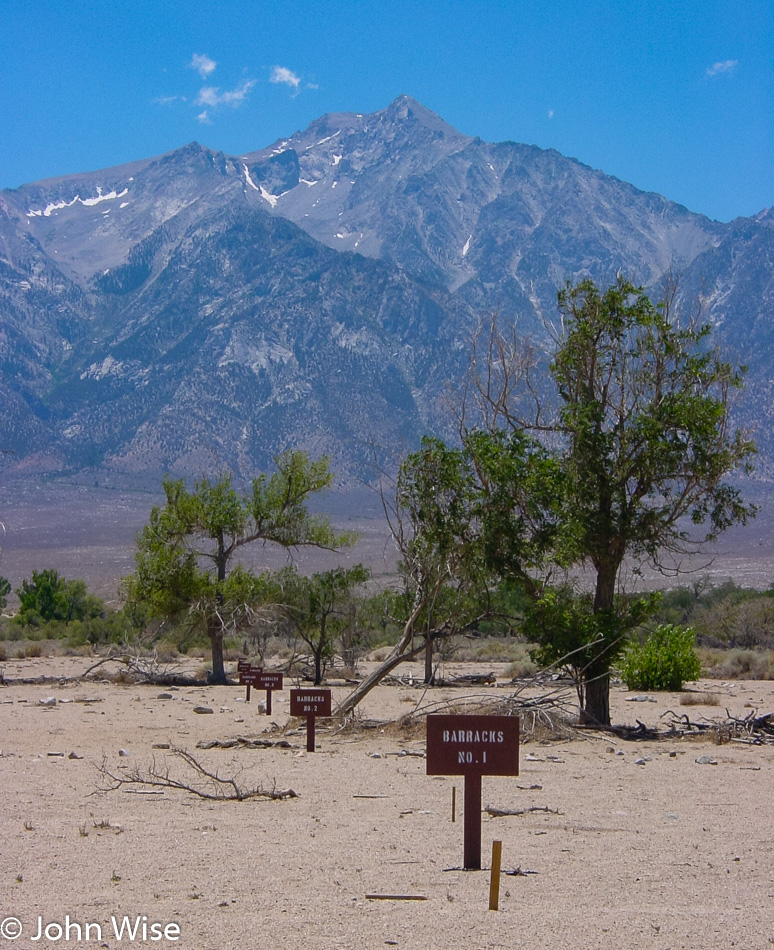
While the barracks and the majority of the manifestations that America operated a concentration camp system were bulldozed, there are still stark reminders that we have a long way to go before we can lay claim to operating a moral compass that can guide others. How is it in the 21st century that we are still talking about civil liberties, equal rights, educational disparities that appear to be institutional and biased against people of color, a correctional system that also displays an ugly bias, and the list goes on and on? While the barracks are gone now, ask a Native American how different their reservation is from a camp in the desert that took away the rights of a people, ask a Mexican American in hiding from immigration authorities how free they are beyond picking our food or cleaning our yards to travel, or ask a gay couple how comfortable they are to hold hands in public? Hell, a woman cannot even breastfeed her child in public without raising the ire of the intolerant mob.

Our country is vast; its founding documents are inclusive and welcoming. Yet our actions of isolationism scream louder than the words so eloquently placed on that parchment. There is room for all in America, but our fear of others and our disdain for those falling outside of conformity are a weakness that will continue to hamper our future until the time comes when we can confront our stupidity for what it is.
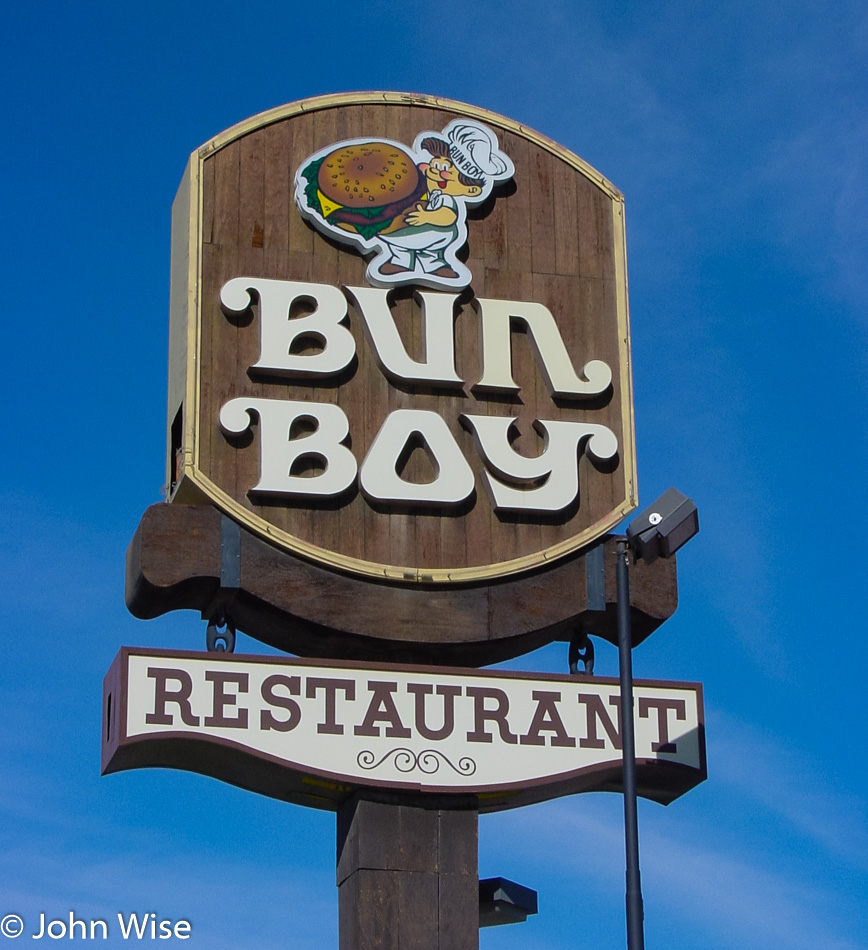
The deep-fried zucchini was pretty good, but the Mexican food was HORRIBLE.
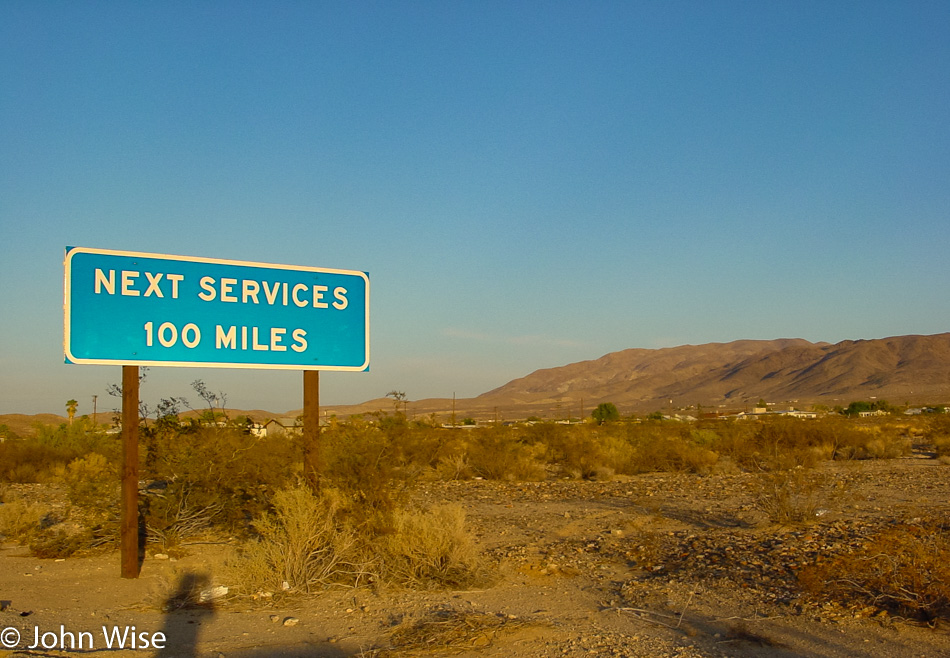
This is one of those signs that let you know just how big America is. Never in Europe would you be warned that you will not find services for the next 162 kilometers; as a matter of fact, you can’t drive 15 km in Europe without running into another village.
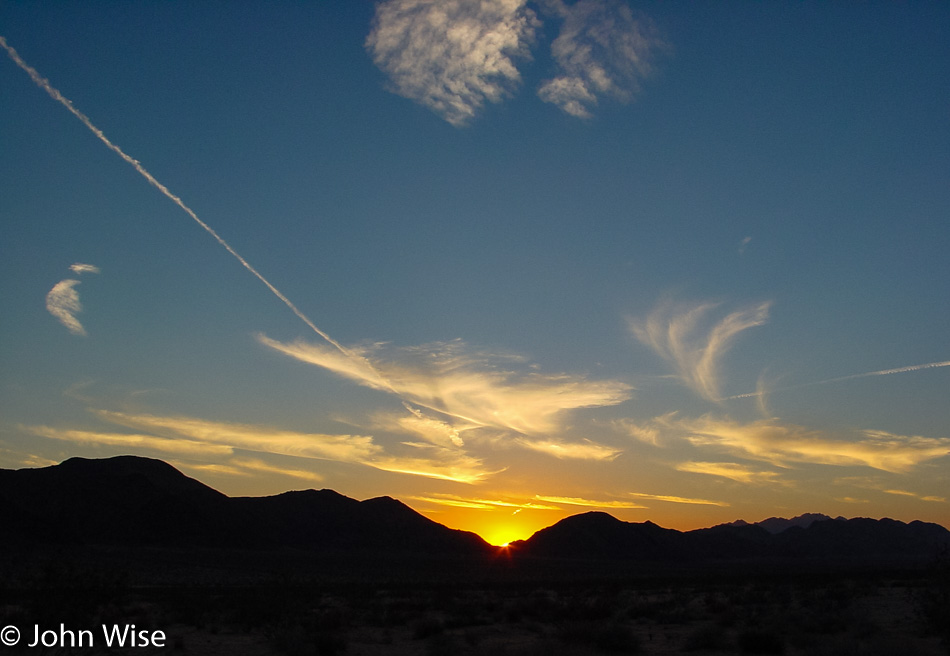
The sun sets on the West and our Independence Day adventure. Tomorrow, that very same sun will return, creating a new dawn, but too many of us will not wake up to this idea of reinvention and new adventures; we will instead drag the same old version of ourselves out of the previous day. Race past your habits and desire to stay in place and get out on the road, both in reality and metaphorically. The world is ready to be embraced and experienced, even if it’s in fits and spurts that don’t allow for total immersion. Better to have tasted the victory of knowledge and beauty than to be a prisoner of an outmoded construct of physical and mental stagnation.

When we get home, we’ll pay for these long days as we collapse in exhaustion, but for now, we just keep going. This morning, we were out of the motel and on the road by 6:15. We are on the approach to Lassen National Park.
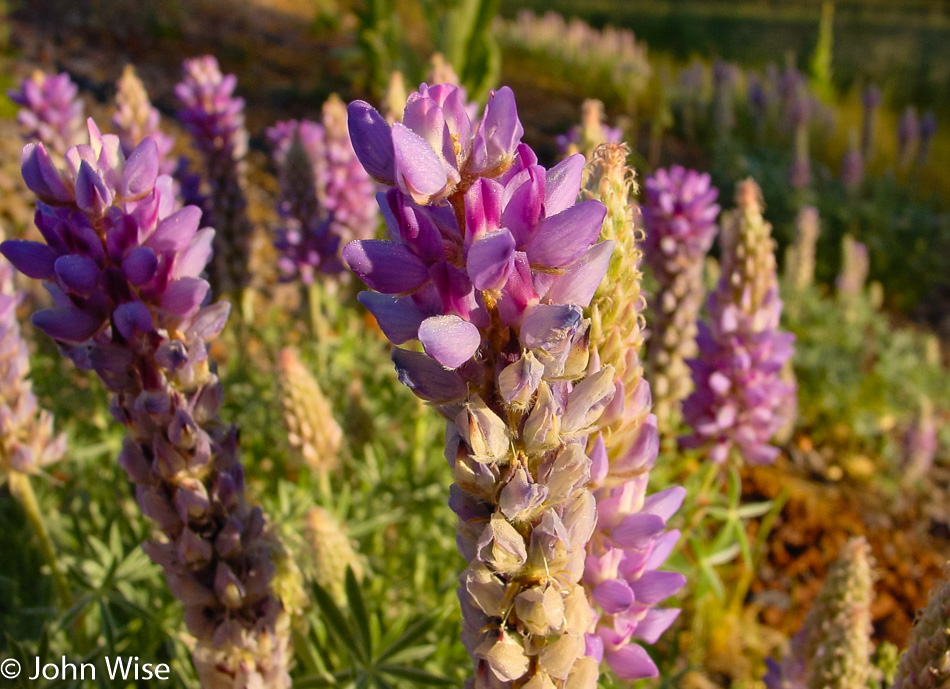
It is this stuff here that delays us getting places in a timely manner, as flowers are a powerful attraction and scream at us to stop and take photos. While we’re in the throes of quickly stopping the car, jumping out, grabbing the photo, and getting going again, it seems rational and perfectly reasonable to think, “What the heck, it’ll only take a minute,” except these minutes add up and it’s probably never as fast as I hope. Part of the allure of these races to get out and around is to capture enough elements that when we look back at the visual arch of the trip, we will be inspired to visit some of these spots again or if there was an abundance of mediocrity we can relegate that corner to the pile of “not interested.”
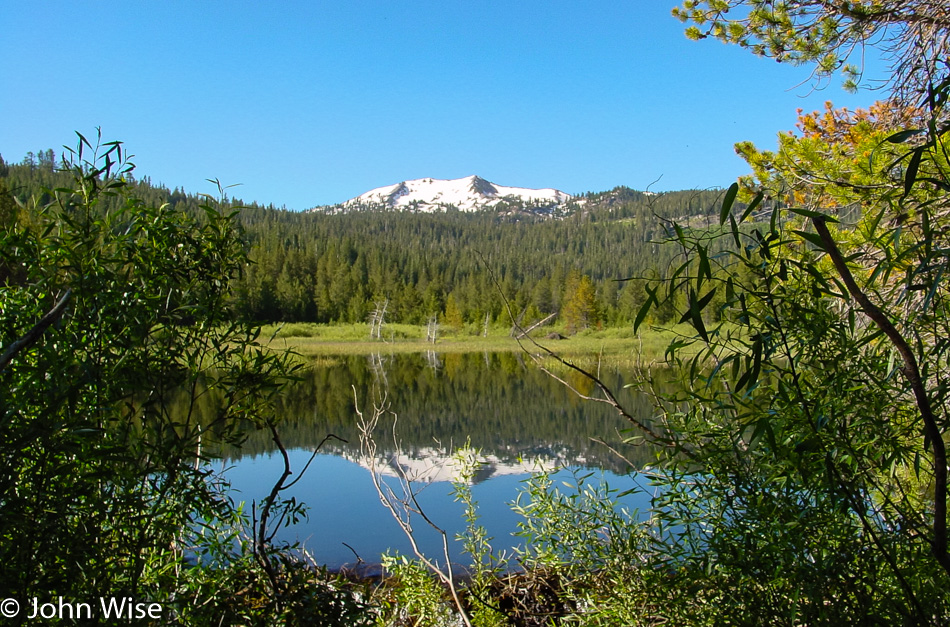
This is Hat Lake and one of the first big indicators that there’s more to this park than the southernmost active volcano known as Mount Lassen, which is the main draw for our visit today.
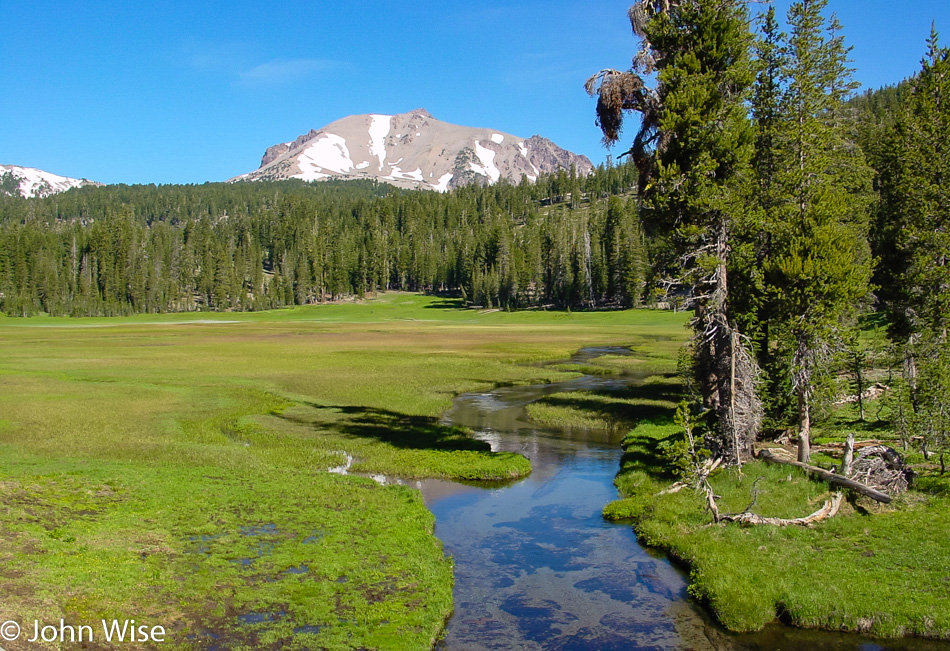
Kings Creek runs through this meadow; unfortunately, we weren’t prepared to do the same. Next time in Lassen, remember to bring waders. And this is how it happens for us to be drawn back to a place; these beautiful impressions continue adding up until we reach astonishment levels. This will be accompanied by a bit of sadness that we weren’t able to fully explore this meadow, but then again how in the world does anyone on a five-day trip that takes in Bonnie & Clyde’s Death Car, Devils Hole Pupfish in a remote corner of Death Valley, Ash Meadows Refuge, the Rhyolite ghost town, fireworks in Lakeview, Oregon, Crater Lake National Park, Lava Beds National Monument, Lassen National Park, Yosemite National Park, Lake Tahoe (coming up later today), Mono Lake and Manzanar National Historic Site (giving away where we’re going tomorrow) and not need to be quick about it?
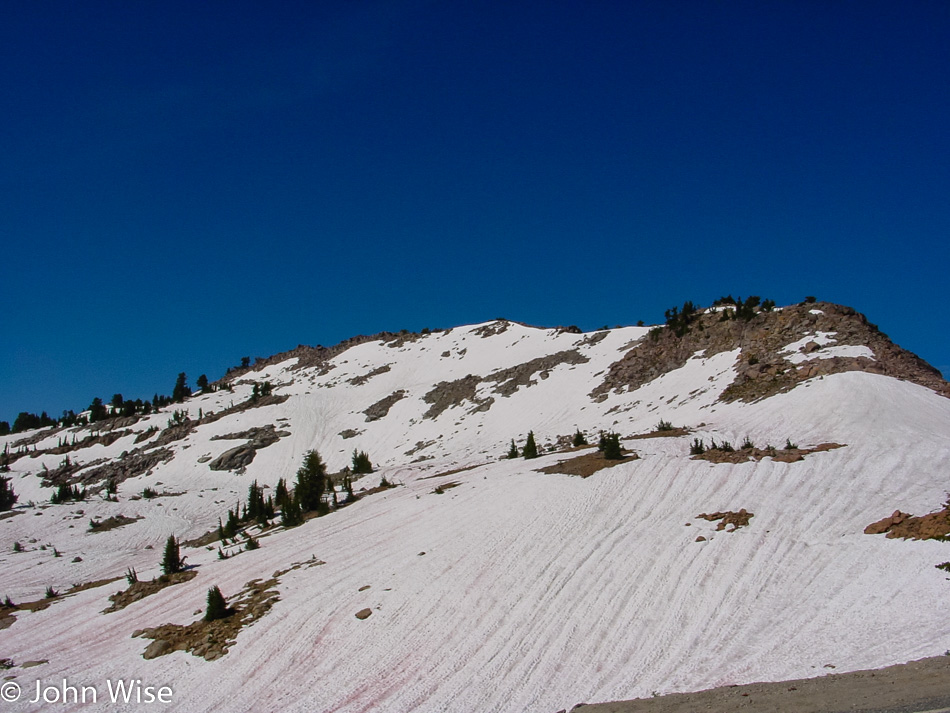
This is Mount Lassen, and while there’s a path to its peak, this will not be the trip where we make that hike.
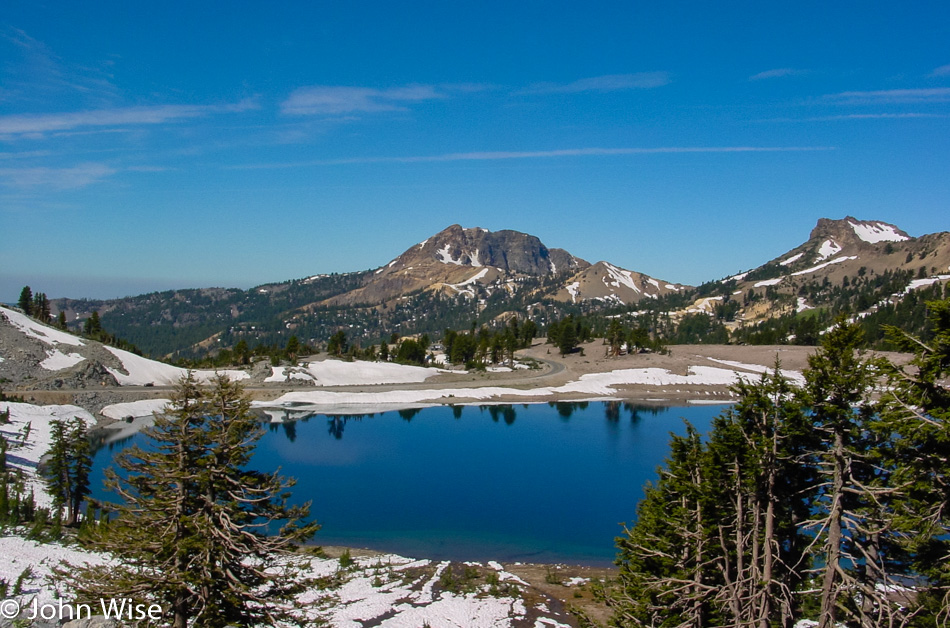
Lake Helen alone could be a great reason to visit Lassen. Fortunately, there are 1000 other compelling reasons to be here, too.
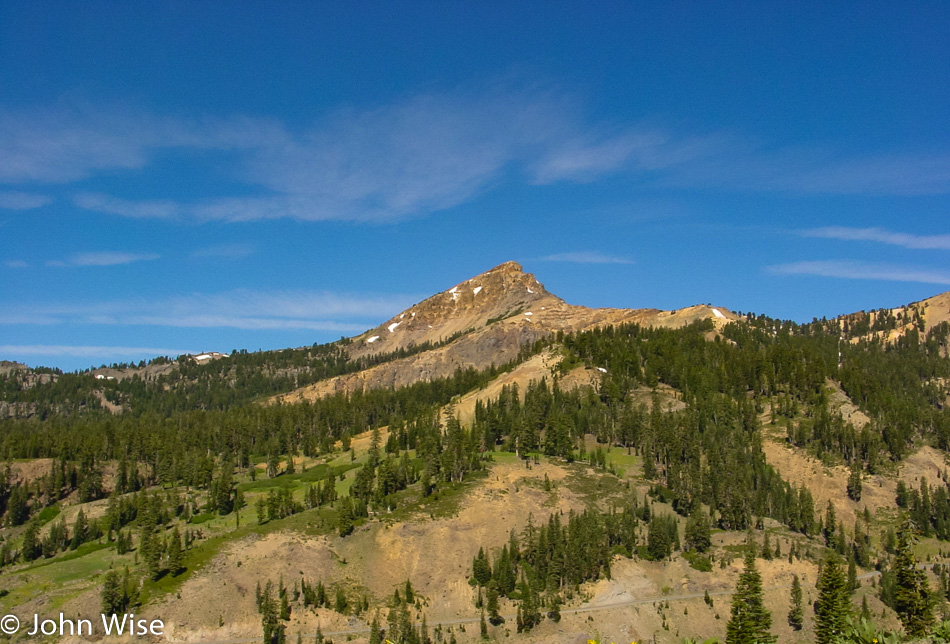
The terrain is varied and beautifully seductive. Our three-hour bullet tour can never do this park justice, but at least now we know that if we planned a couple of longer hikes here, the time spent would be well worth the effort.
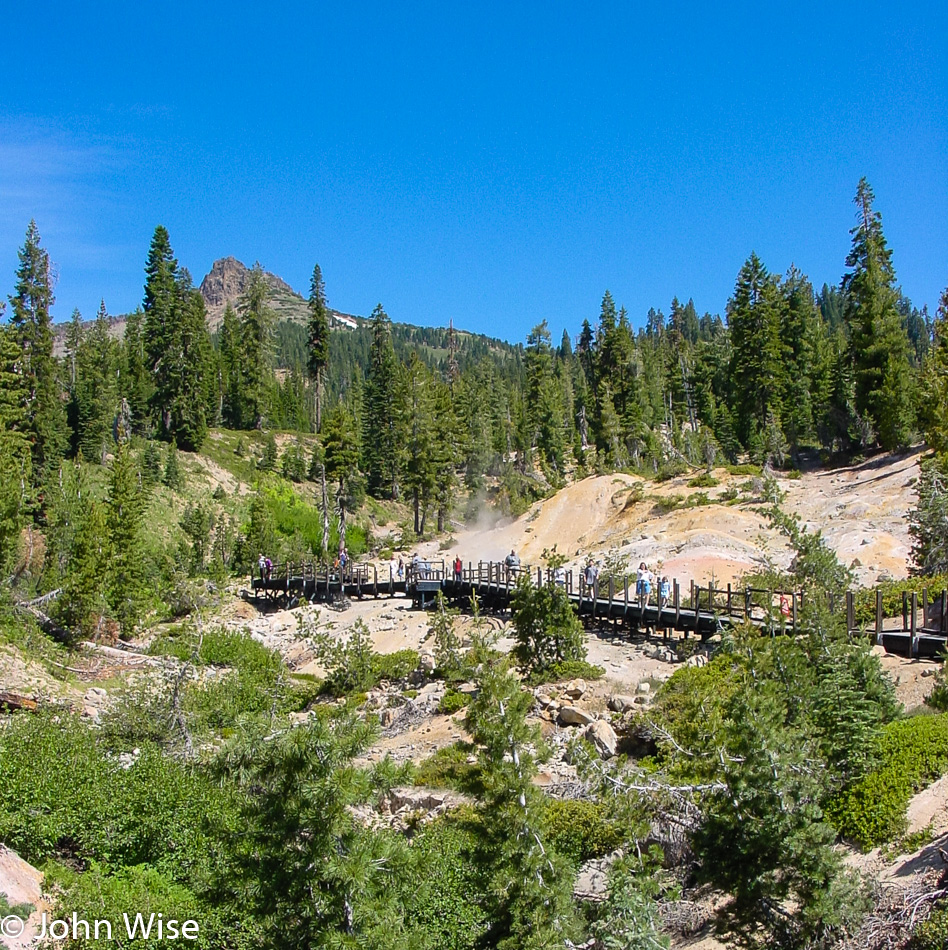
Visiting the Sulphur Works hydrothermal area is an immediate reminder to your nose that this is a geologically alive area. Volcanic activity has been a large part of Lassen’s past and could still be a part of its future.
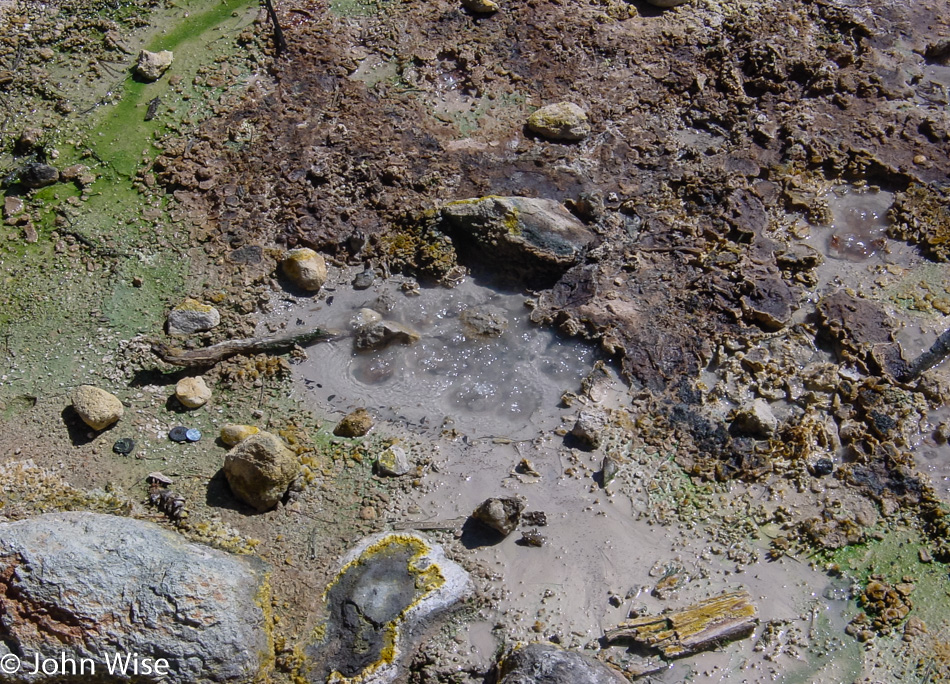
Gases and boiling water suggest something is cooking below. Mount Lassen’s lava dome is the largest on earth and is definitely still active, with its last eruption occurring back in March 1915.
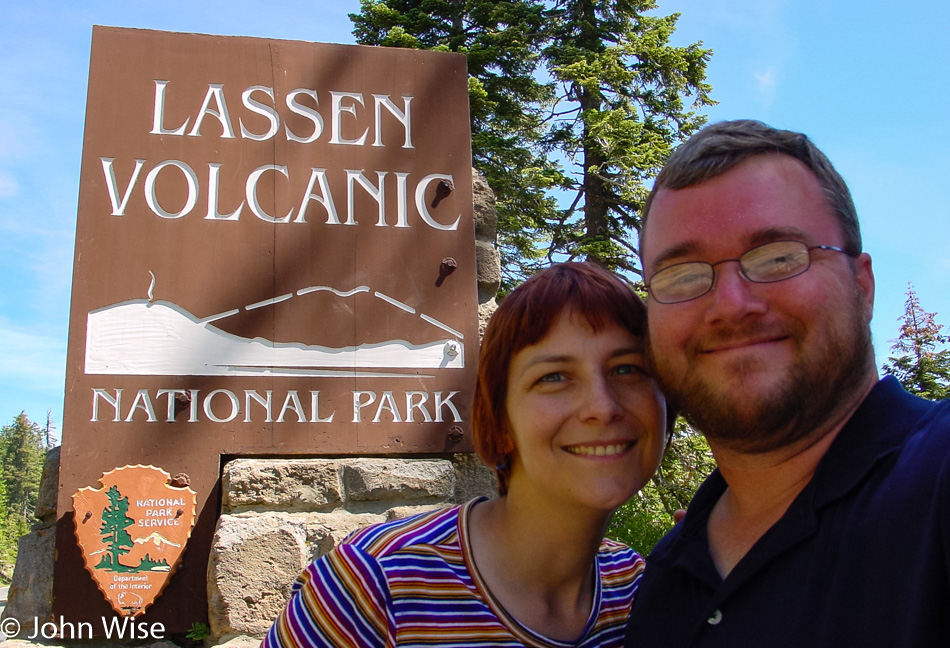
Here at the southern entrance is the sign we’d been looking for on our way into the park this morning, hence why it’s being shown as we exit the park.
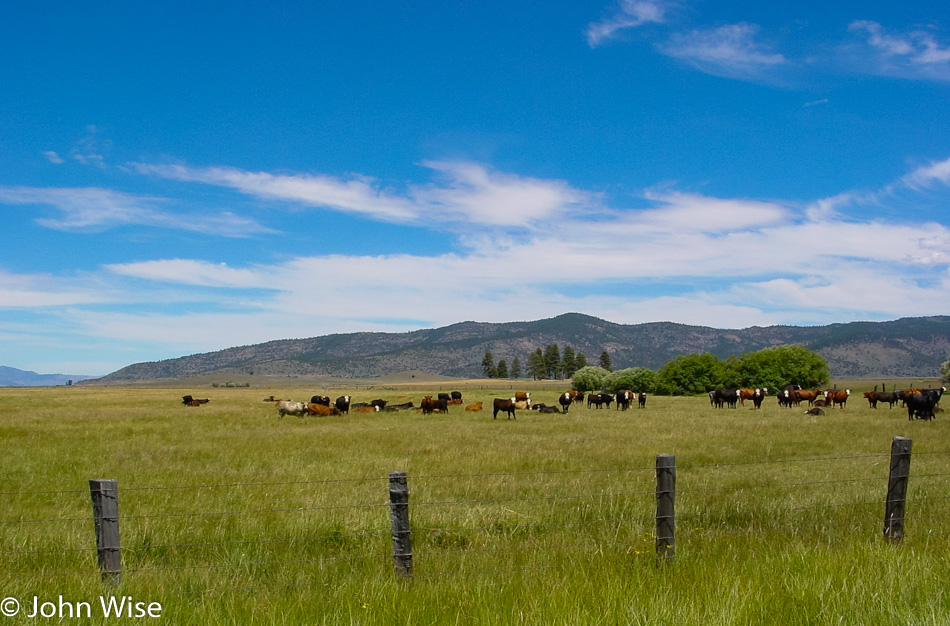
What a great day to be out driving in northeastern California.
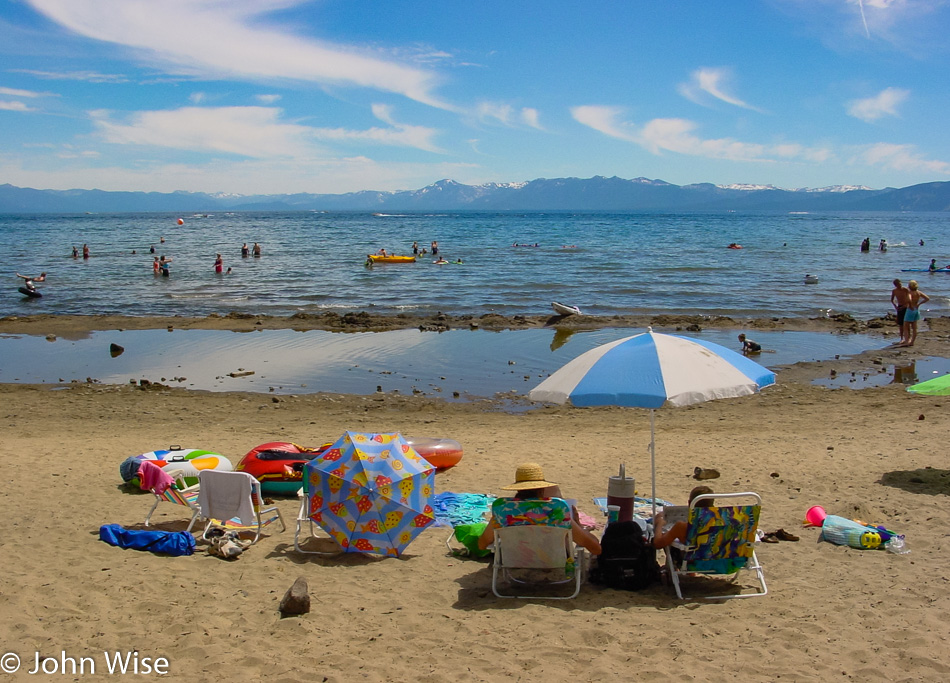
Lake Tahoe is a beautiful place, but with the bumper-to-bumper traffic in town, this is coming off the list for a return visit around any holiday weekend. I know, famous last words.
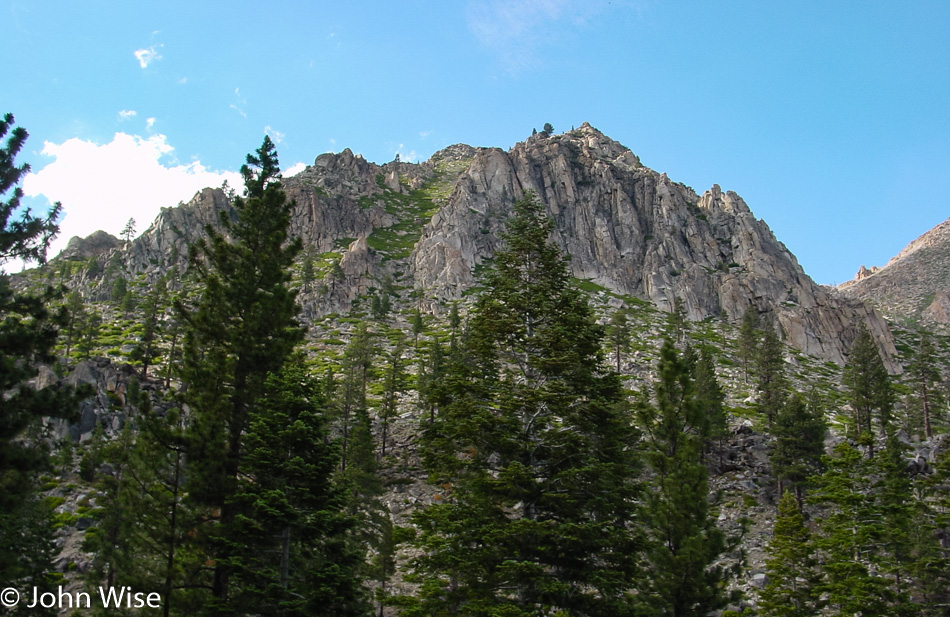
The mountains of the western United States are a treasure comparable to the extraordinary beauty found in the Alps of Europe. It’s kind of funny how when we are not among these marvels, they are “out of sight, out of mind,” but when we are here, I want to remain in their towering stature and bask in their glory, I’m guessing that’s how many visitors feel after visiting this vast land that reaches into the sky and our hearts. Again and again, I should return to these mountains and the memory of John Muir, who not only founded the Sierra Club but worked tirelessly to protect hundreds if not thousands of square miles that include Yosemite, the Sequoias, Redwoods, and uncountable locations in between.
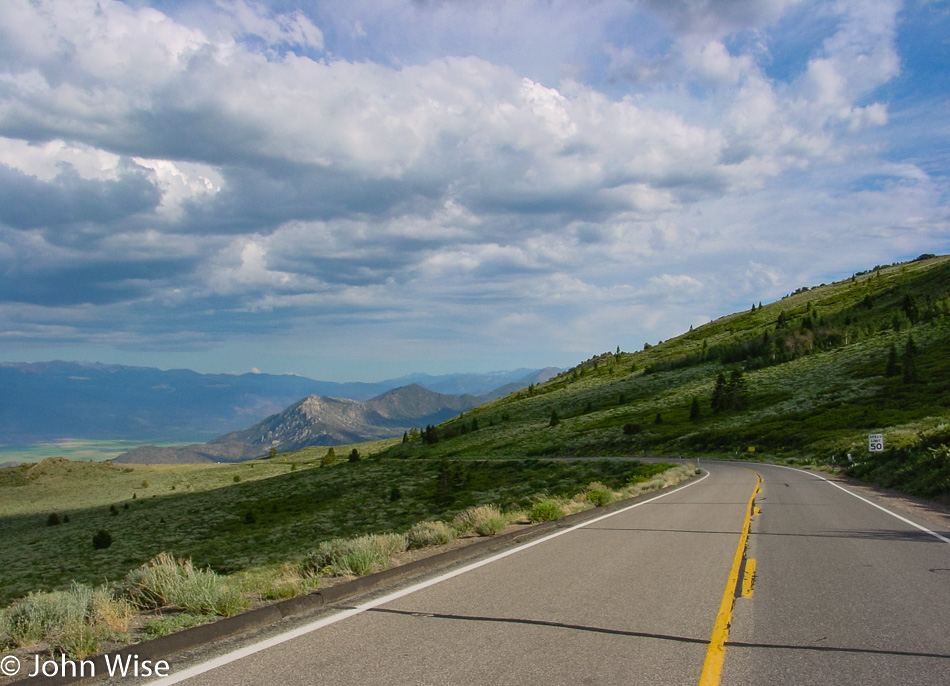
To those who drag heavy machines and asphalt out to the sides of mountains, taming the land so we might cruise along the edge of a place without needing to ride a horse and spend valuable time that is in short supply: I thank you all.

I should probably link higher resolution images to these panoramas as they are much better storytellers; when you can see the details that we saw that day and that are still present in the photos, maybe I’ll get to that task one day.

That’s Mono Lake in the distance, and we need to decide if we should drive down there or not.

Nobody needed to twist our rubber arms as the car seemed to have a mind of its own and pulled us in closer until we were right next to the shore. Who would have ever dreamed that we would visit two endorheic places in one long weekend? Endorheic basins or lakes (such as Crater Lake) have no outlet, and while Crater Lake is always being replenished by a lot of rainfall and up to 44 feet of snow per year, Mono Lake is a saline body of water similar to the Great Salt Lake in Utah and the Salton Sea in Southern California.
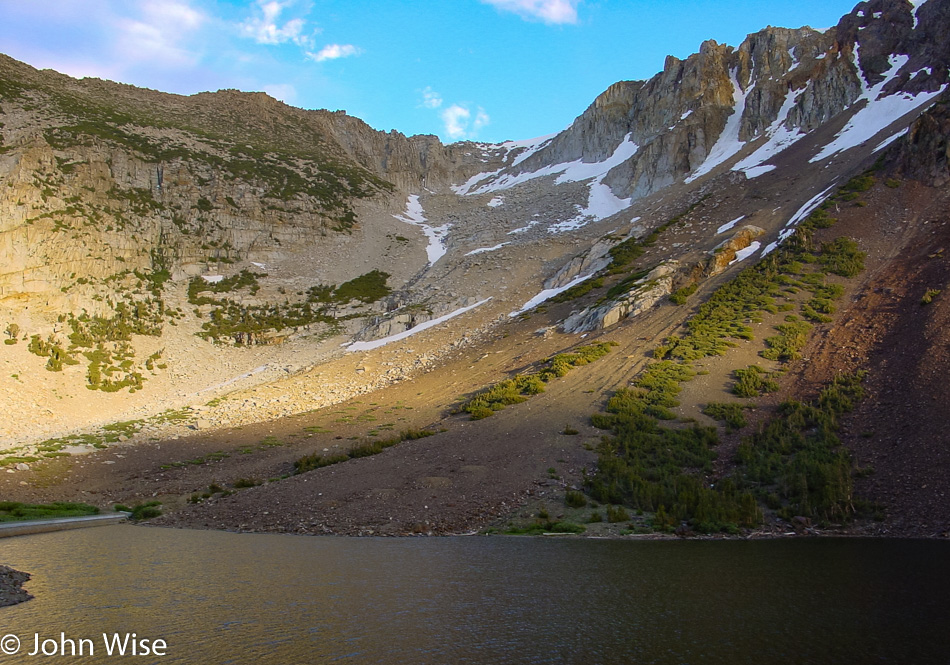
Once again, we are on the move, hunting for a perfect sunset.
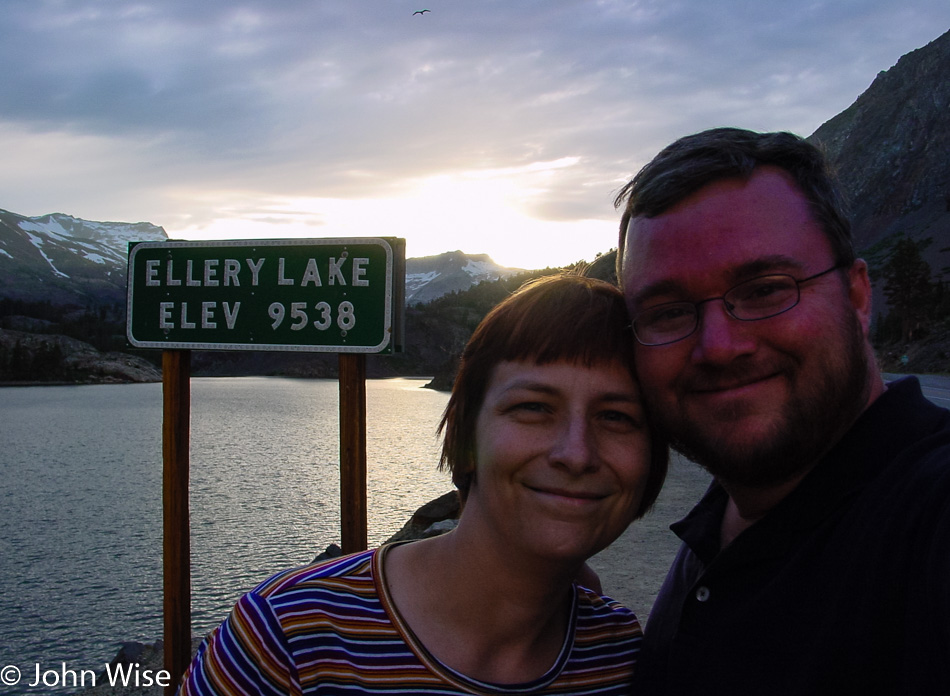
Well, this seems like a great place for a sunset, but what about further up the road? And what road might this be? We are in Yosemite National Park, having come in via the east entrance.
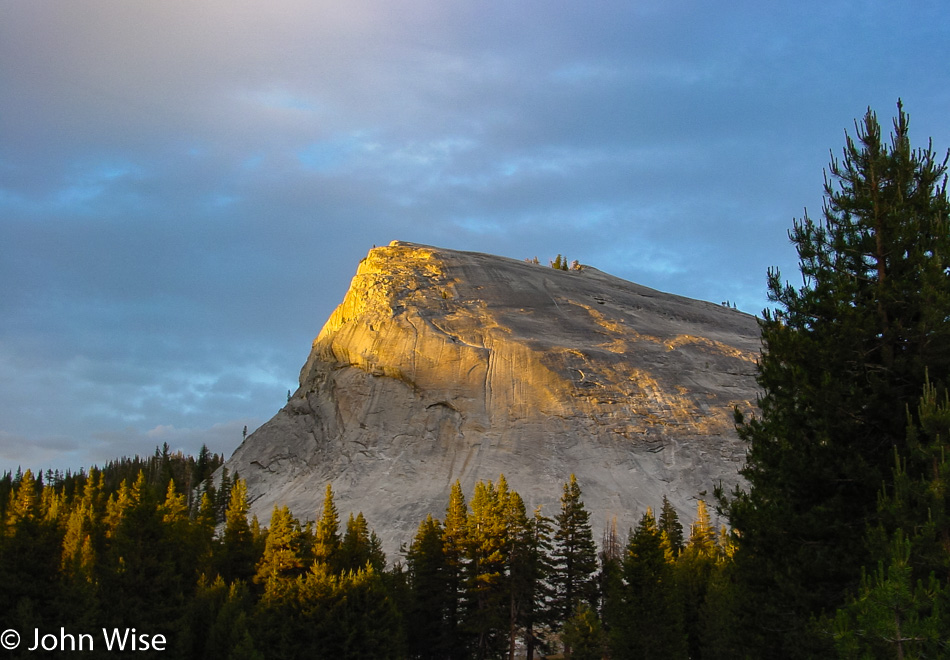
Lembert Dome in Tuolumne Meadows is almost the perfect place for sunset.
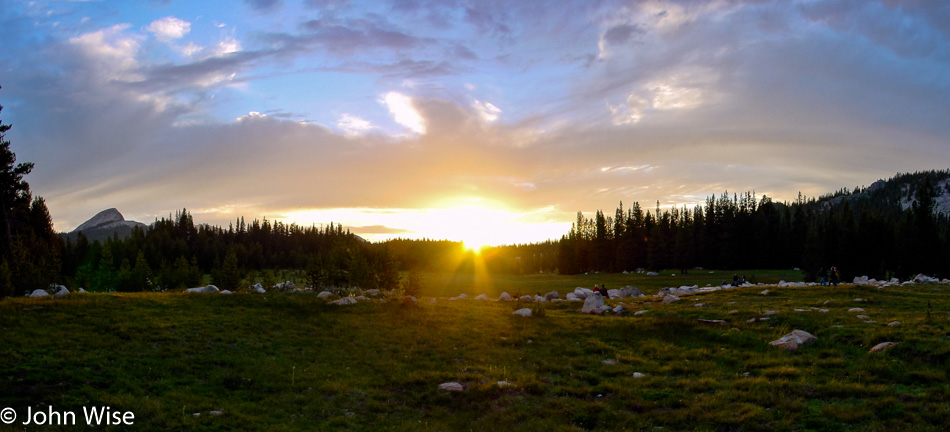
And then we find THE perfect place with the perfect light on a perfect day right smack dab here where we are in the meadow.
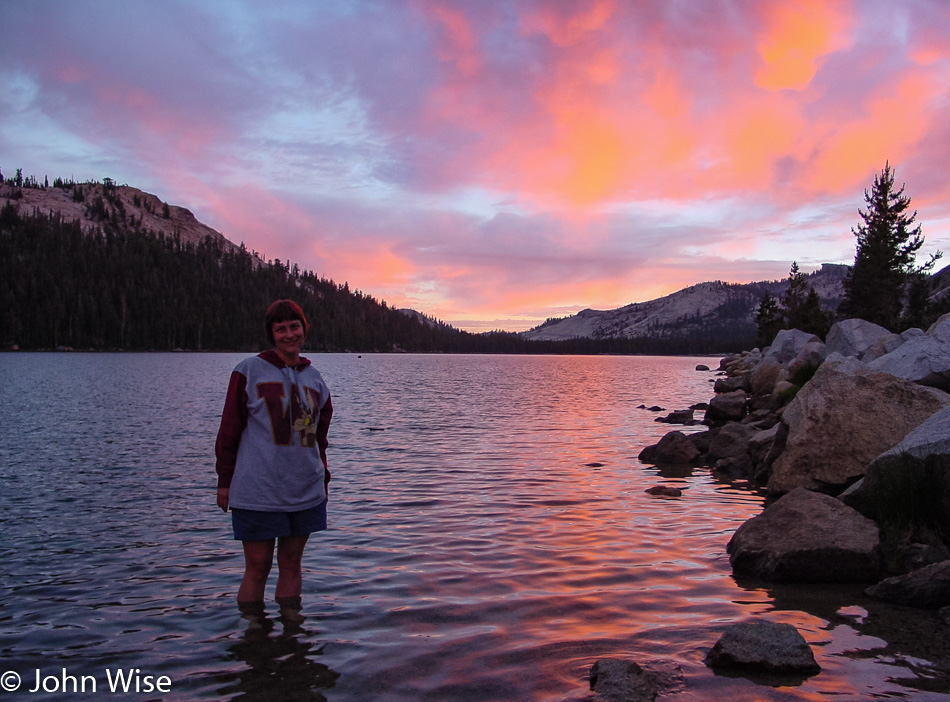
Tenaya Lake is where we’ll snap the last photos of the day before heading back down the eastern side of Yosemite. This is an alpine lake with a surface elevation of 8,150 feet (2,484 meters), which is probably the highest body of water Caroline has ever stood in. If you are wondering about the temperature of the water, she let me know it was cold, really cold.
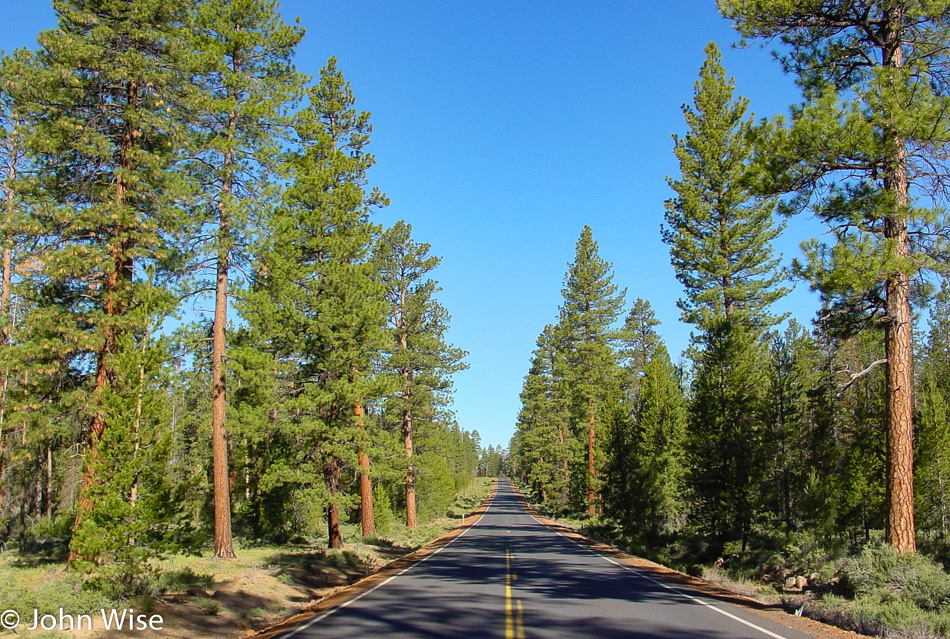
Though we were up late last night for the fireworks, we still woke up shortly after the break of dawn this morning and were getting gas by 6:30 (we’re still unaccustomed to having someone else fill our tank here in Oregon). Between stretches of the forest, we also drove through some beautiful meadows and spotted four pronghorn antelope basking in the sun while we basked in their glory from our perspective driving by.
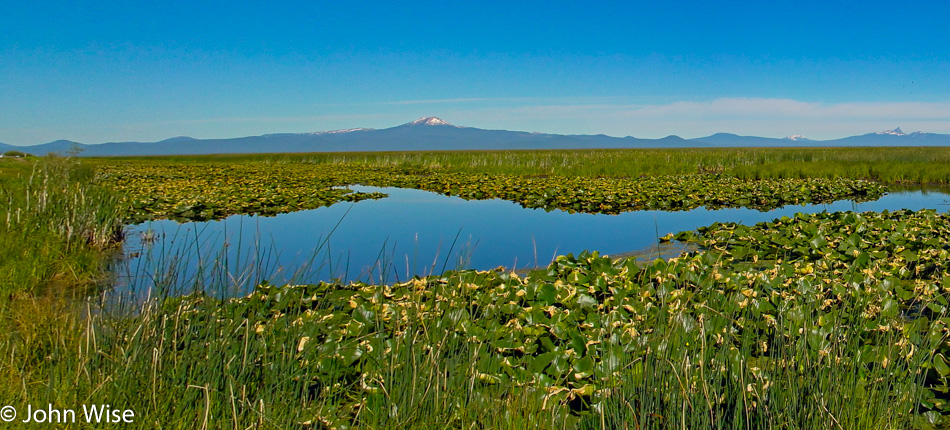
Our path wasn’t the most direct, but it was certainly scenic. County Road 676, also known as Silver Lake Road, passes through the wetlands next to Wocus Bay and the Klamath Marsh National Wildlife Refuge. While passing through the refuge, we spotted a beaver, cormorants, and geese.
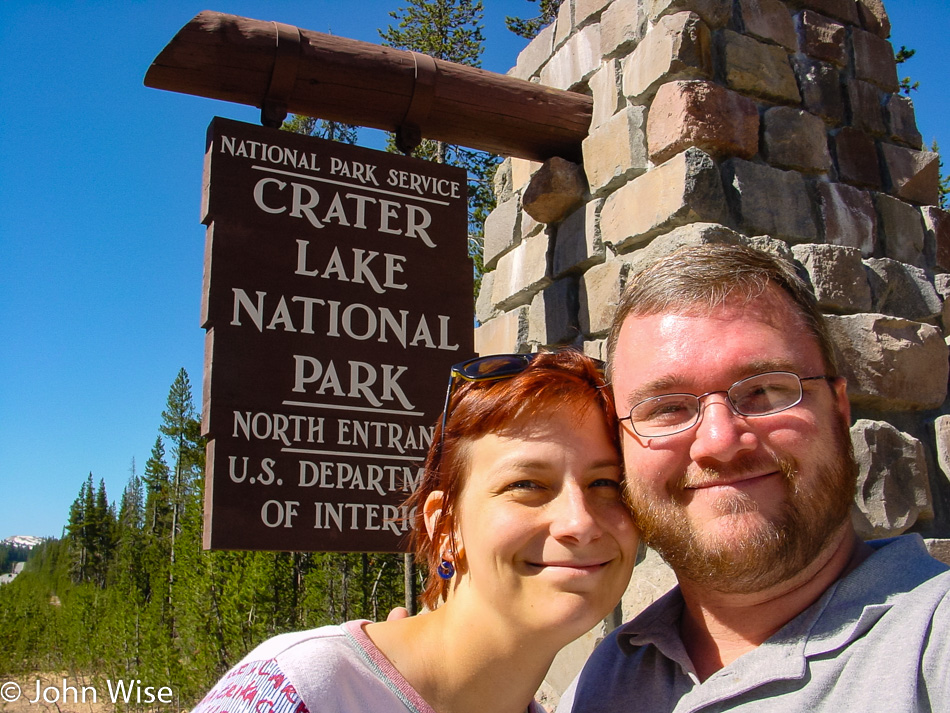
By 10:00, we are pulling into Crater Lake National Park, and the furthest northwest we’ll travel on this extended long weekend, Silver Lake on the way here this morning was a bit further north. After checking out the park map, it’s decided to take the loop drive around the lake going clockwise.
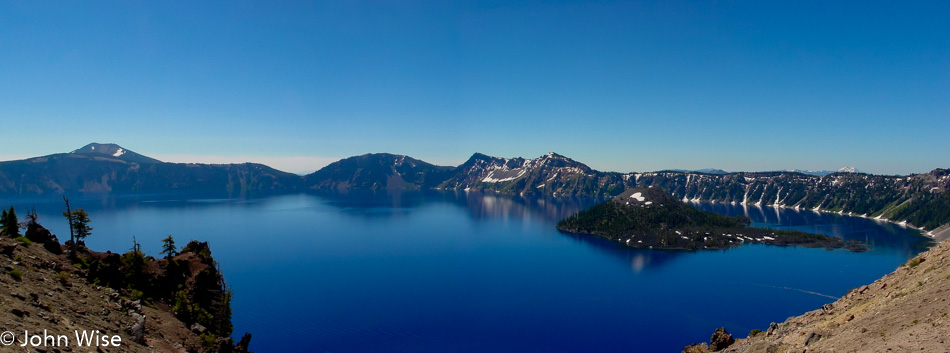
Our view of the lake is a spectacular one. The color of the water is the bluest we’ve ever seen; maybe it has something to do with how deep it is, as it is the deepest lake in the United States at 1,949 feet or 594 meters. Or maybe it’s the elevation here where the caldera rim reaches heights of 8,000 feet or 2,400 meters above sea level. Maybe it’s the fact that no stream or river runs into the lake, as this lake has been filled with rainwater and snow. But the reality is that it’s probably the combination of all these factors. On the right of the lake is Wizard Island, which is a cinder cone formed about 7,000 years ago. The island’s peak is 767 feet above the surface of the lake, but incredibly, it sits on the caldera floor over 2,000 feet down below. The trees on the island have never been harvested, with some of them clocking in at over 800 years old now.
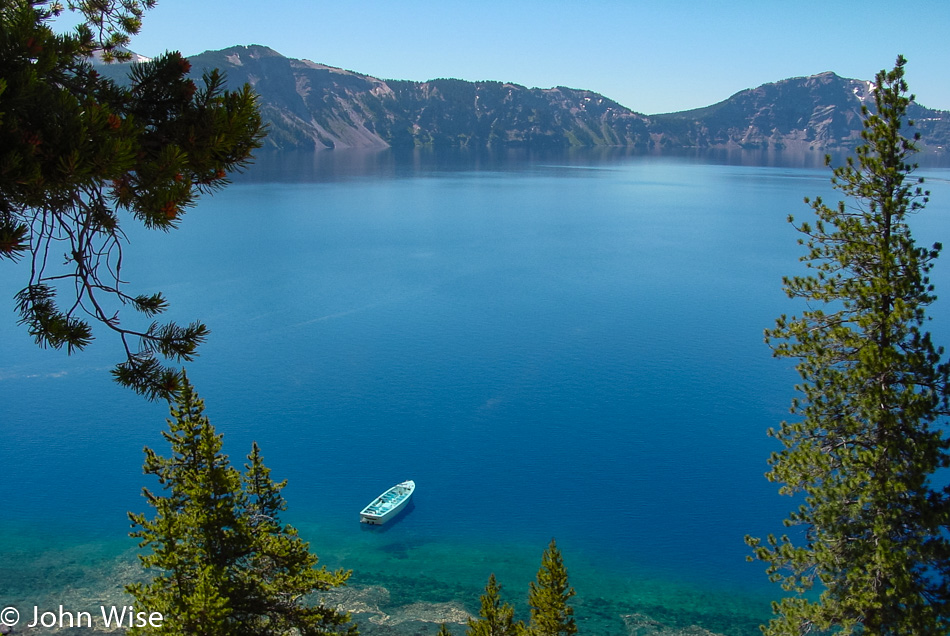
We are heading down the Cleetwood Trail which is the only trail in the park that takes you lakeside.
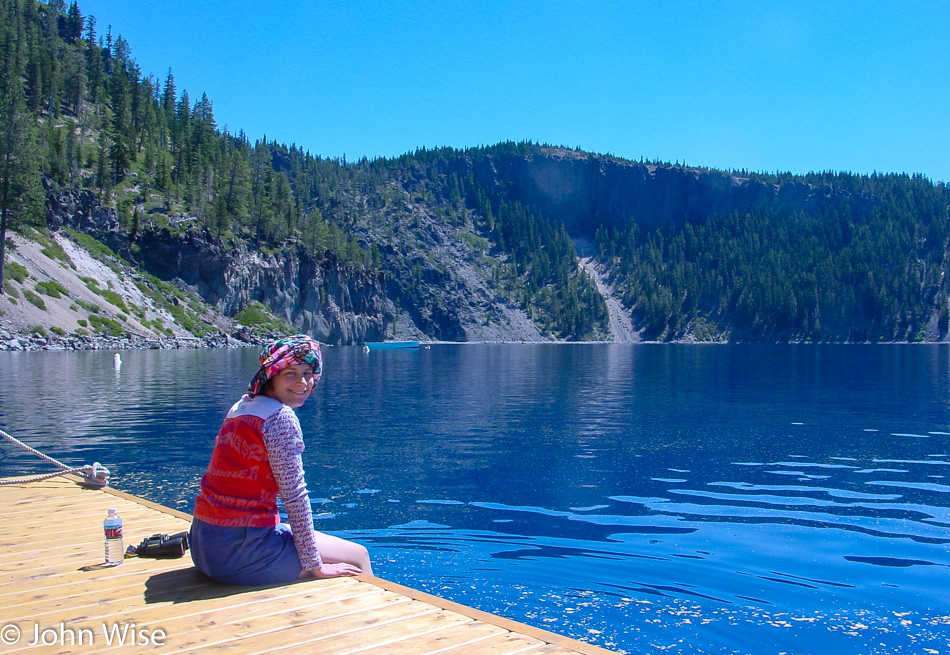
Kind of a strange thought that we are atop a 2,000-foot-deep caldera here at water level and that where Caroline is sitting used to be a mountain peak that towered over a mile above her. That mountain peak was called Mount Mazama before it exploded in a fit of volcanic fury just 7,700 years ago. While in human terms, that might seem like a lot, in geological terms, that was a split second ago.
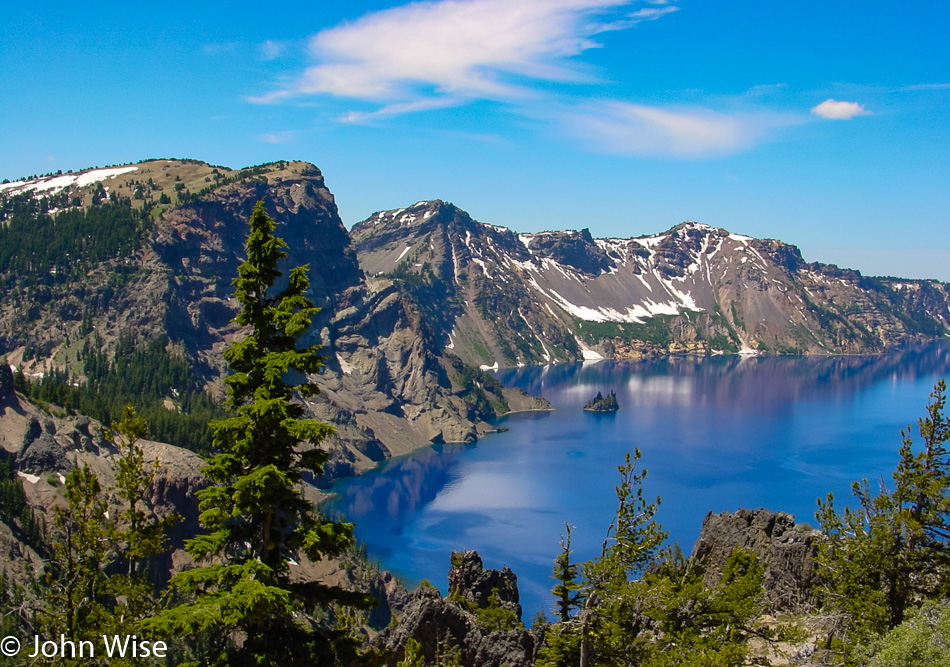
The scenic drive doesn’t exactly follow the crater rim; east of the lake, we drove through a beautiful canyon complete with several waterfalls, including a larger one called Vidal Falls. A little bit further down the road, we returned to the lakeside and were able to catch this great view of Phantom Ship, that black rock in the lake that stands 170 feet high.
Just three hours after our arrival we were already heading for the exit but stopped at the visitors center for some tchotchkes because life without a fridge magnet is meaningless and empty.
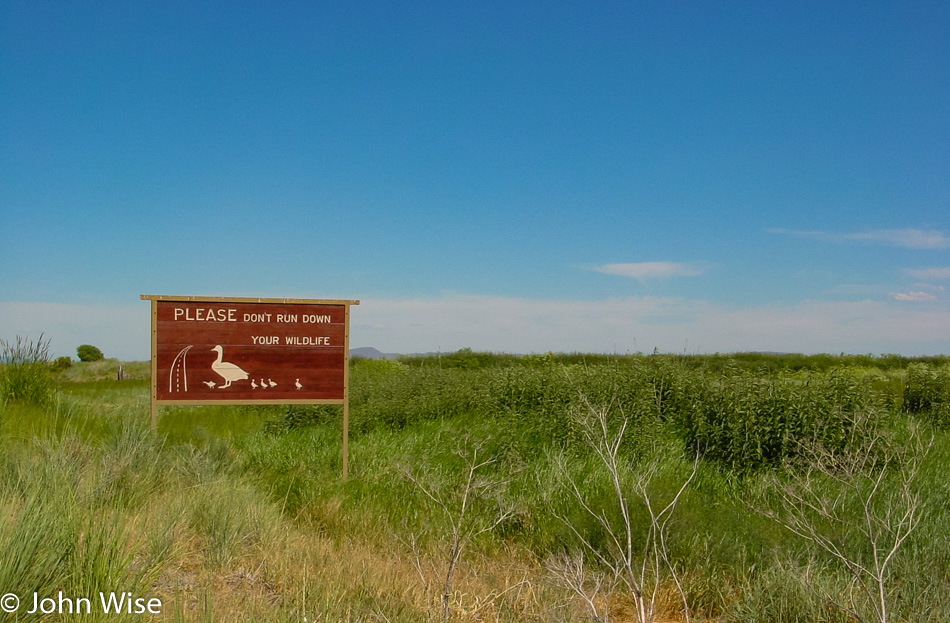
Driving south towards California, we pulled over to a scale and learned the useless information that our car weighs 1350 pounds. After arriving in California, we stopped to pay a visit to the Klamath Basin National Wildlife Refuge in Tulelake. Here in the refuge, we spotted some black-necked stilts, glossy ibis, and western coots, so like the sign points out, “Don’t run down your wildlife.”

Just a few minutes south of the refuge, we enter Lava Beds National Monument and are nervous that the visitor center might already be closed as it’s a bit after 5:00. With that in mind, we stopped here at the Devil’s Homestead Lava Flow overlook and were just as quickly off and running again hoping the visitor center might be open longer than others.
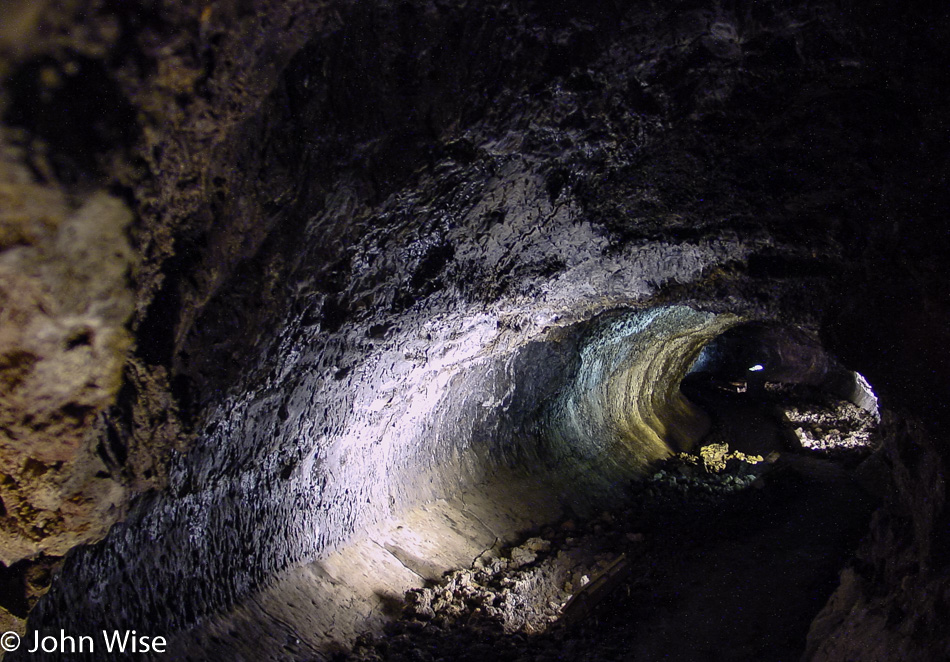
Wow, the visitors center is open until 5:30 leaving us 10 minutes after we arrived to buy a magnet and find out what else we can do with our shrinking day. Drats, there are no magnets, might as well go home! Just kidding. We walked over to the closest and most easily accessible lava cave equipped with lights, explanatory signs, and a stairway right in the visitor center parking lot. One of the major attractions at Lava Beds is that people can explore over a dozen of these caves; helmets and lamps are available at the visitor center for the unprepared, as long as one arrives in a timely manner. Lava caves are formed when the flowing lava cools off on the surface, building a roof, while the hot lava below continues to run until it empties, thus leaving a tunnel. During the cooling process, interesting underground shapes can be formed, and sometimes these tunnels cross or are re-melted and re-cooled during and after a volcanic event.
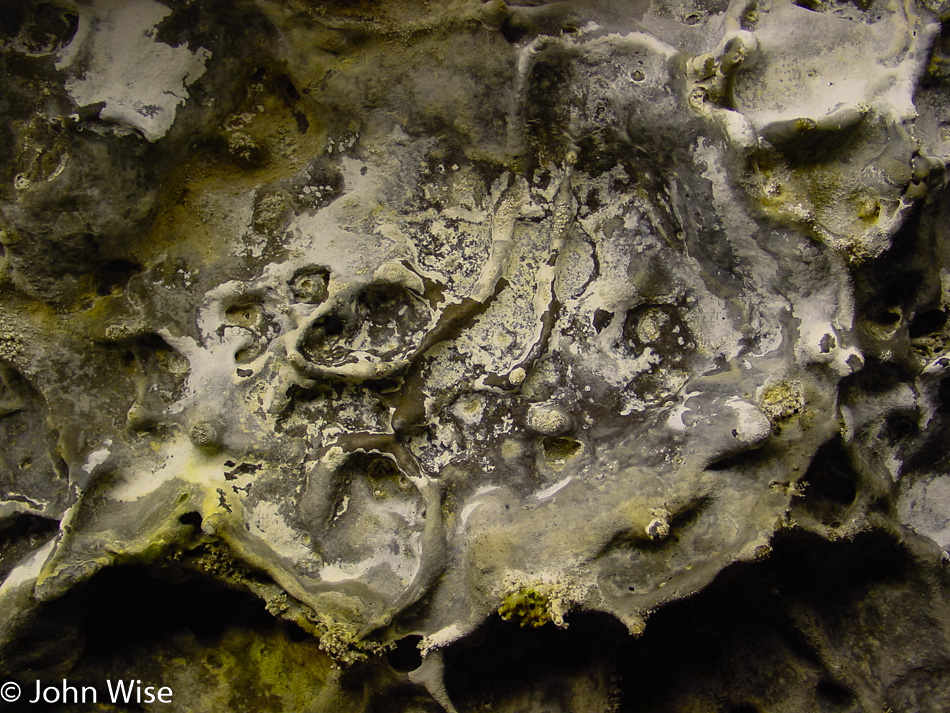
Melted stone, dripping calcified minerals, lichen, a bunch of spider webs, and people have replaced the 2,200-degree lava that once flowed through here, and we’re probably luckier for it.
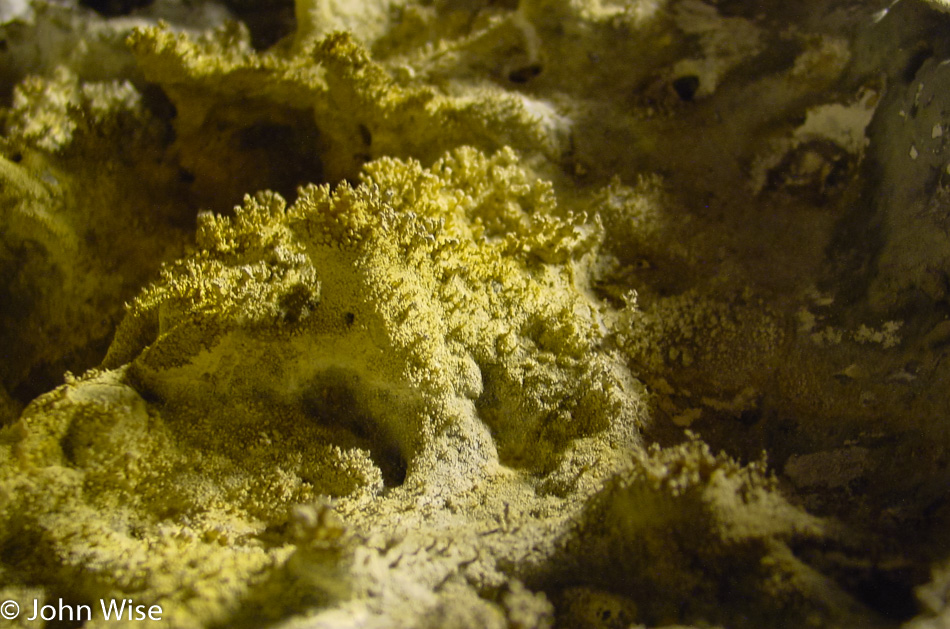
We are out of the cave less than 30 minutes after we entered it; this is the downside of trying to do a little bit of everything in the shortest amount of time.
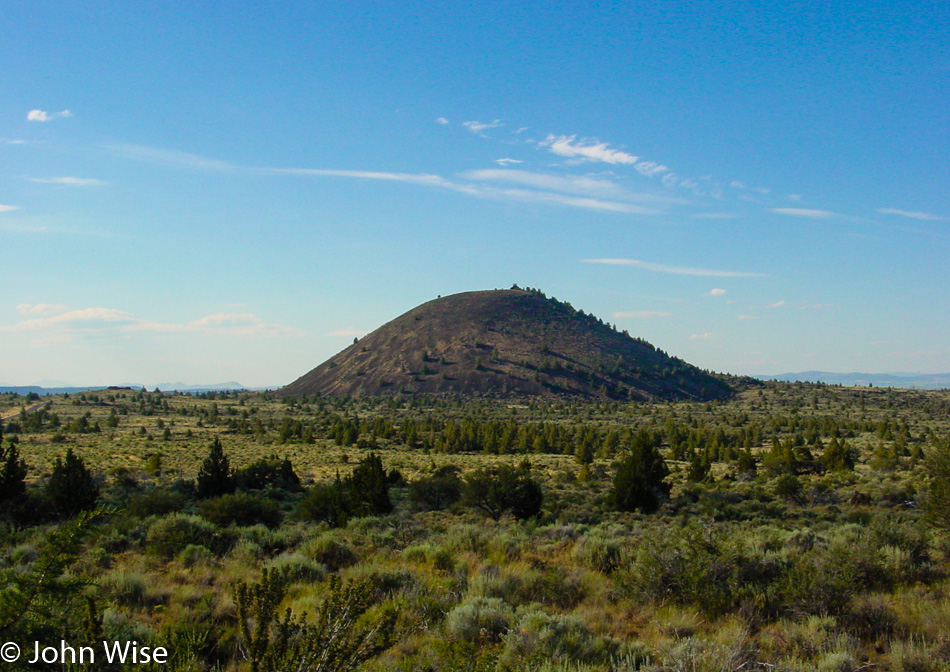
A cinder cone that one day might grow into a full-fledged volcano. Tomorrow, we’ll continue the volcanic theme with a visit to Lassen National Park, but for today, we need to get along as we are hoping to get down to Susanville that on a direct route wouldn’t be too far away, so we’ll take the long way so we can get a glimpse of what you see in the next photo.
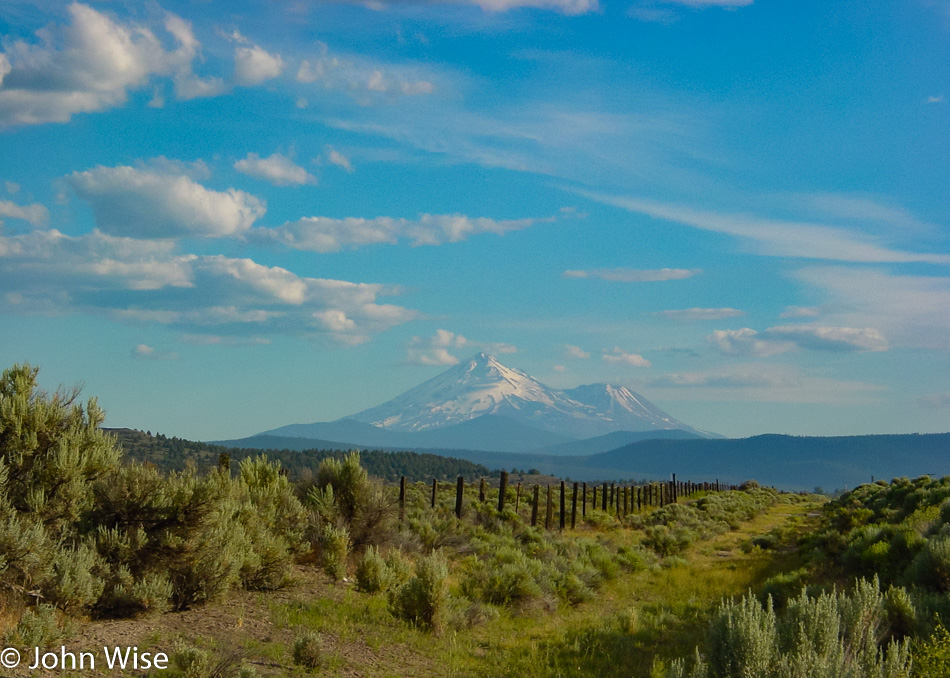
This is Mount Shasta, standing at 14,179 feet above sea level, a dormant volcano. Maybe this road trip should have been themed as the “Volcanic Run.”
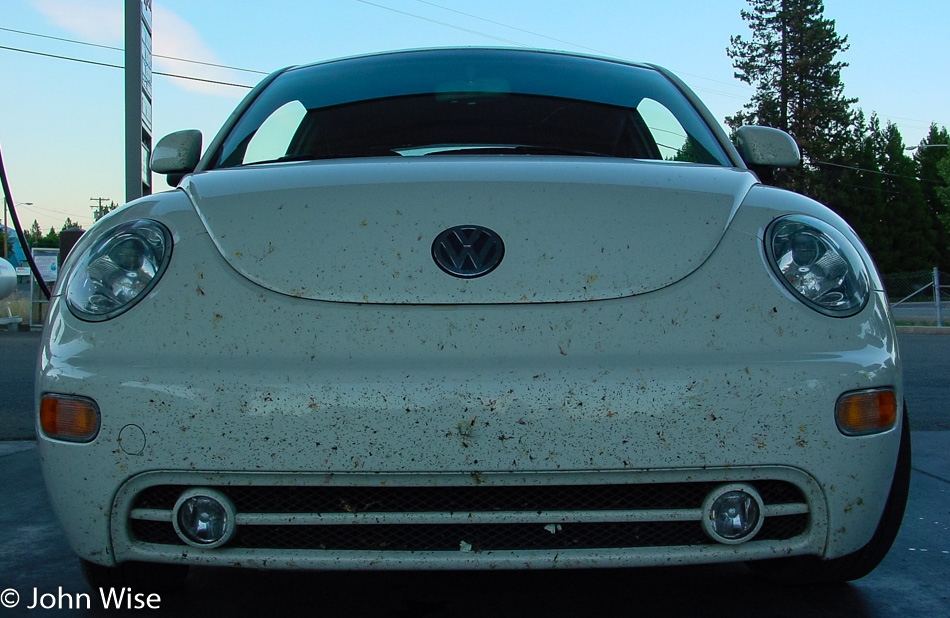
It was quite a detour around Mount Shasta and Weed, California, but I’d seen those iconic images of the Weed sign with Mt Shasta framed behind it and just had to see it for myself. We stopped for gas in McCloud, and while we were enjoying the views, we were almost shocked at the carnage on the bumper. I’ll spare you the closeups.
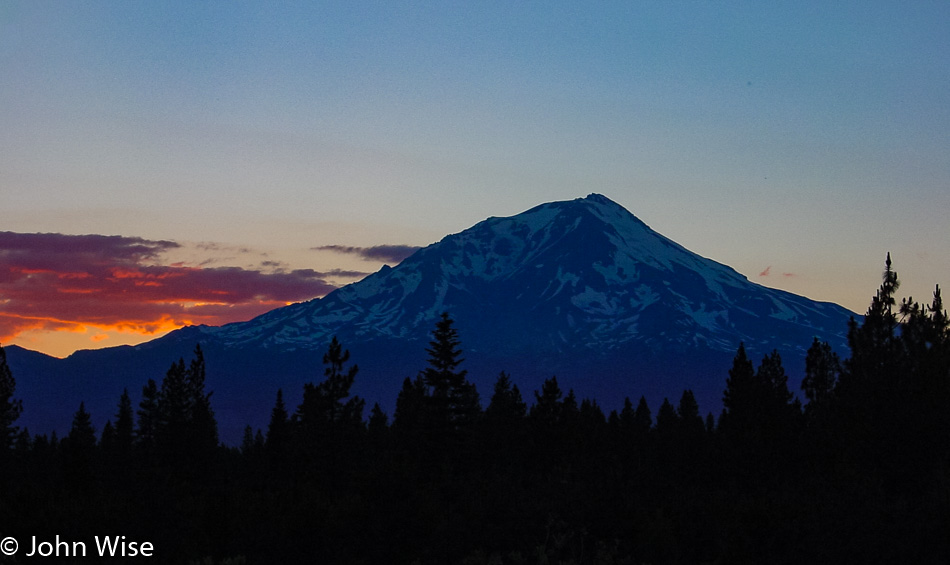
The sun setting in the distance, and yet another view of Mt Shasta.
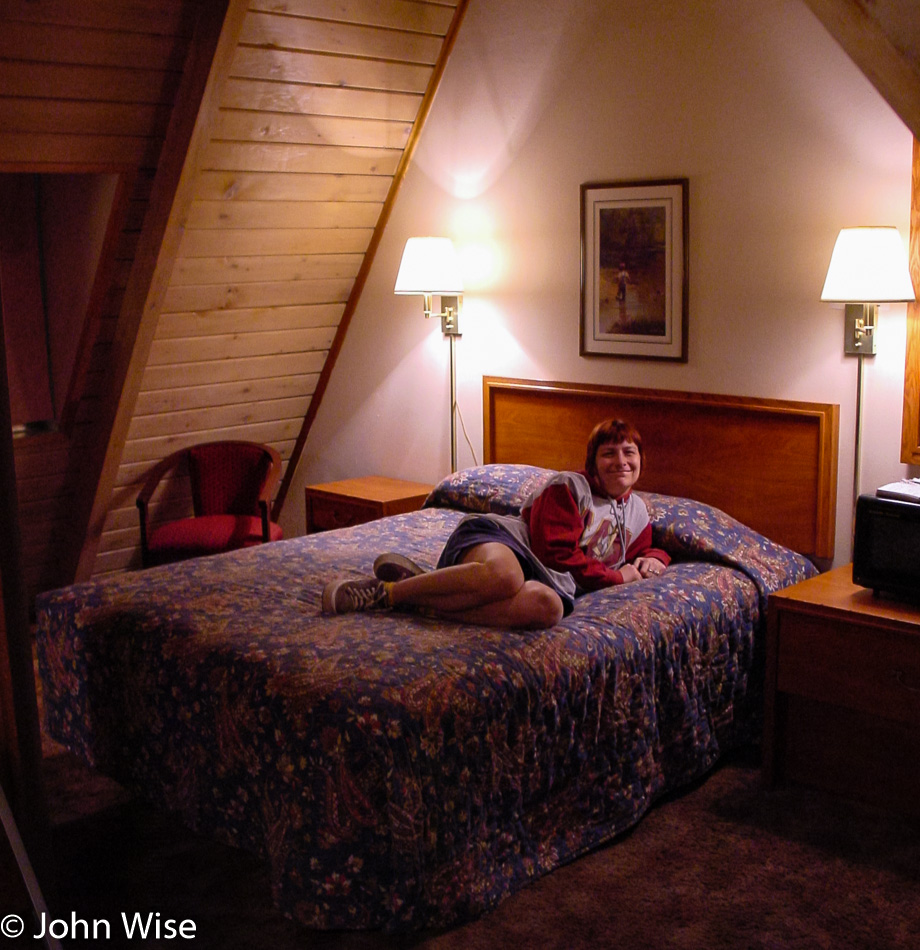
We finally arrived in Susanville, California, at 11:00 p.m. and had a seriously funky room here at the Budget Host Frontier Inn.